Chapter III Lesson 2 From the Age of Renaissance to Realism
1/67
There's no tags or description
Looks like no tags are added yet.
Name | Mastery | Learn | Test | Matching | Spaced |
|---|
No study sessions yet.
68 Terms
Proto-Renaissance (1280-1400)
Period in Italy reviving Greek & Roman ideals, focused on nature, classical learning, and individualism.
Key thinkers: Petrarch and Boccaccio.
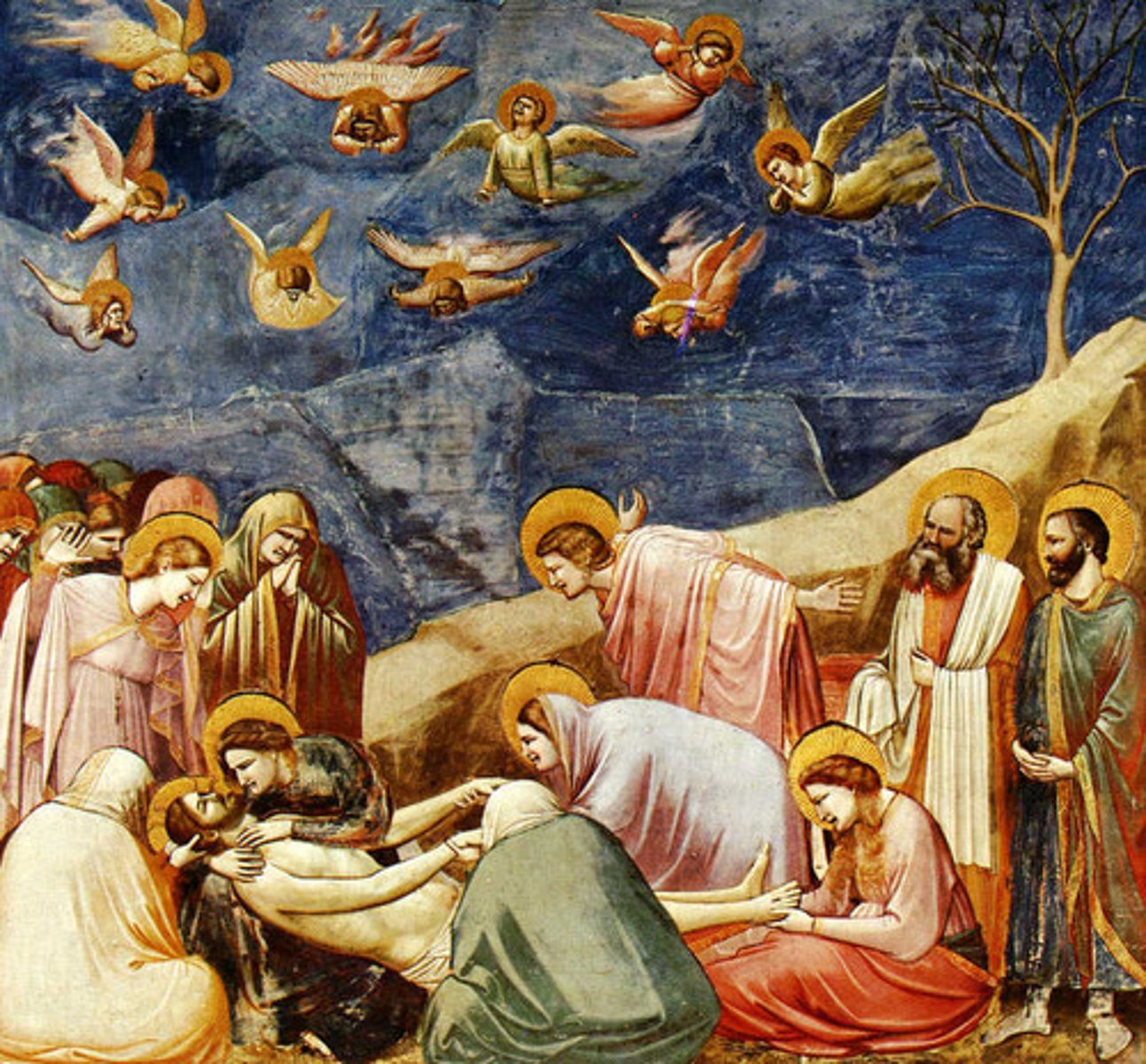
• Awareness of nature
• Revival of classical learning
• An individualistic view of humanity
The Renaissance (14th-16th centuries) transformed painting, sculpture, architecture, music, and literature, driven by three key influences:
Florentine painter Giotto (1267-1337)
pioneered realism in human representation, influencing generations to come. However, the plague and wars of the late 14th century temporarily stalled progress.
Medici
In Florence, much of the early Renaissance's artistic output was funded by powerful merchant families whose patronage played a central role in shaping and sustaining the city's cultural and artistic achievements
Lorenzo Ghiberti (1401)
Won competition to design bronze doors of Florence Baptistery, symbolizing the restart of Renaissance art.
High Renaissance Art (1490-1527)
- Centered in Rome, flourished under Pope Leo X. Characterized by humanism, perspective, realism, and classical revival.
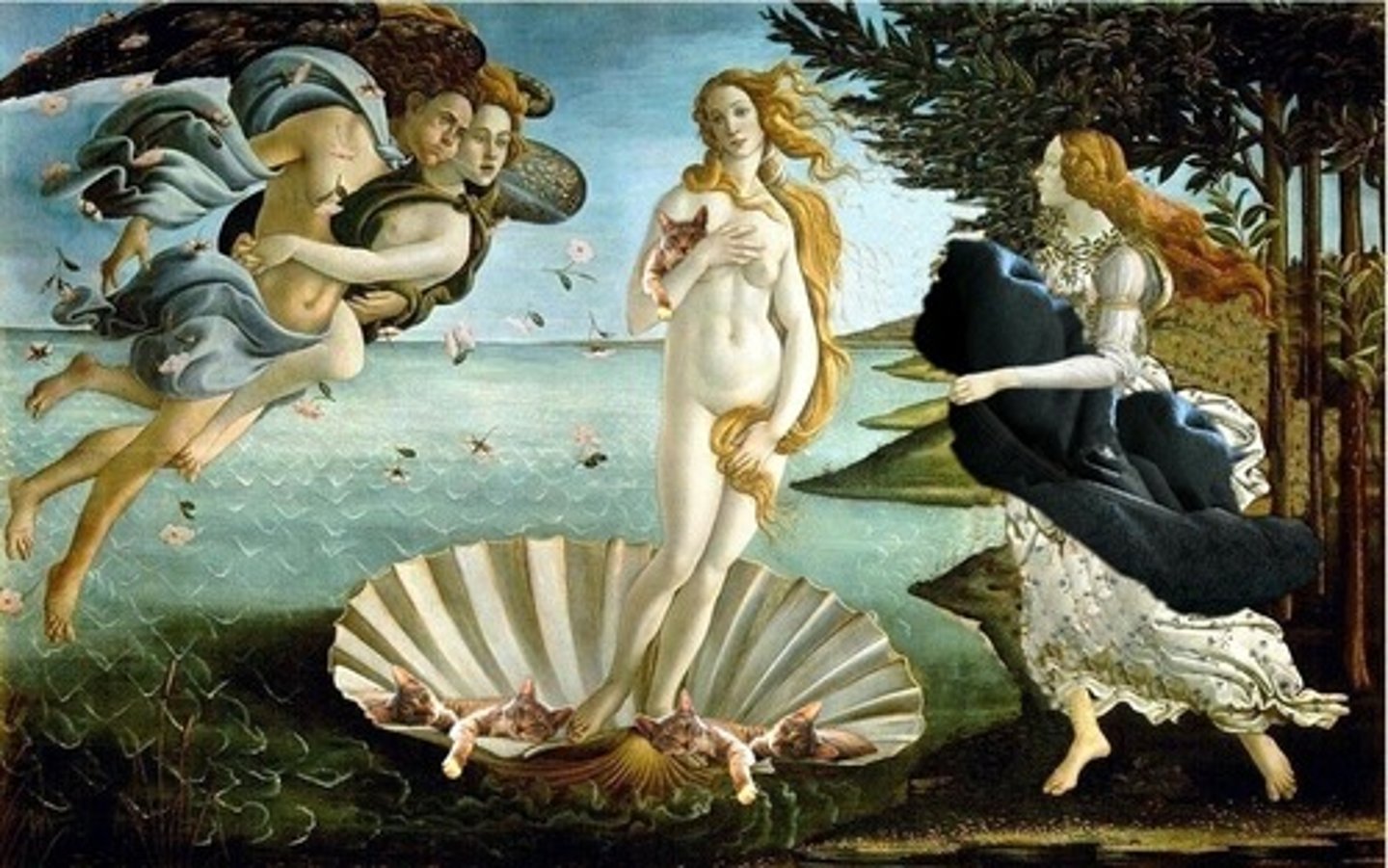
Leonardo da Vinci
- (1452-1519) • embodied the ideal "Renaissance man", combining intellect, artistry, and scientific curiosity.
- His masterpieces—such as the Mona Lisa (1503-05), The Virgin of the Rocks (1485), and The Last Supper (1495-98)—demonstrate mastery of light, shadow, perspective, and the harmonious relationship between figures and their surroundings.
Mona Lisa
- is a half-length portrait painting by the Italian Renaissance artist Leonardo da Vinci that has been described as "the best known, the most visited, the most written about, the most sung about, the most parodied work of art in the world."
- is also one of the most valuable paintings in the world.
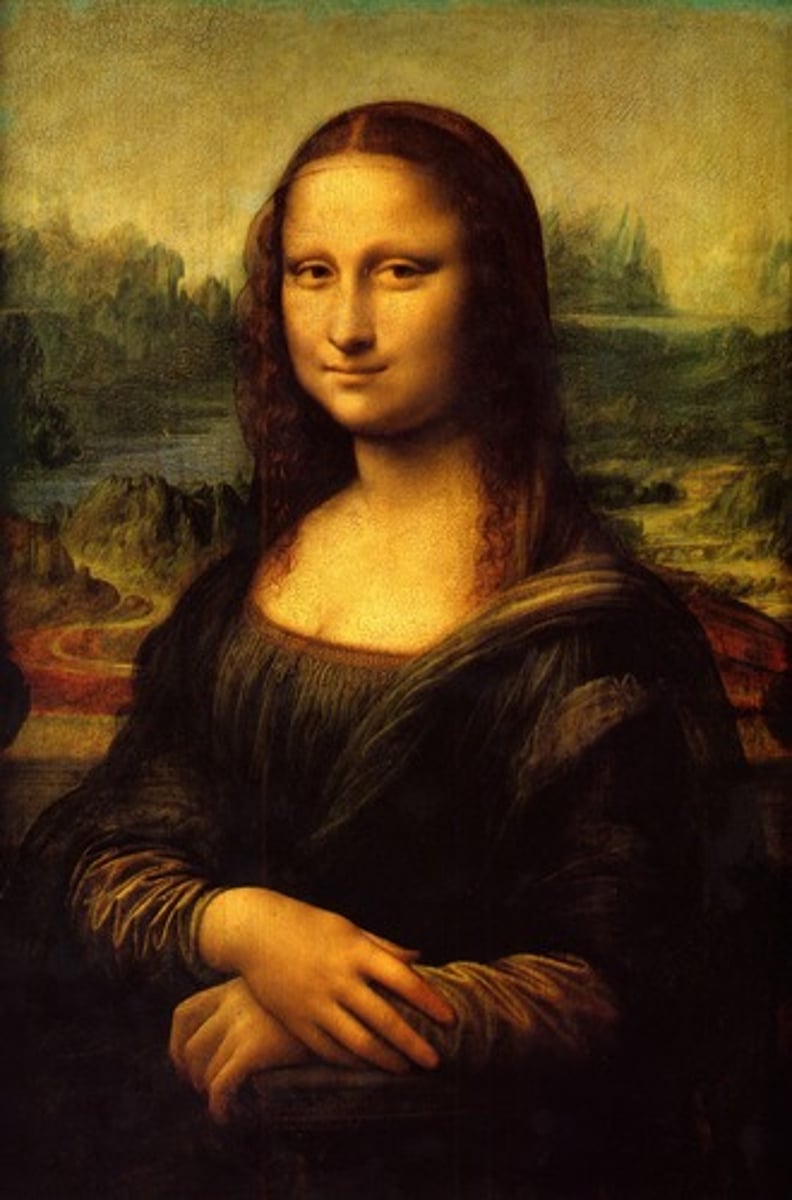
Michelangelo Buonarroti
- (1475-1564) •focused on the human body and monumental scale, making him the foremost sculptor of the High Renaissance.
- His celebrated works include the Pietà (1499) and David (1501-04), carved from a massive marble block and standing five meters tall.
- Although he saw himself primarily as a sculptor, his monumental frescoes on the Sistine Chapel ceiling (1508-12), depicting scenes from Genesis
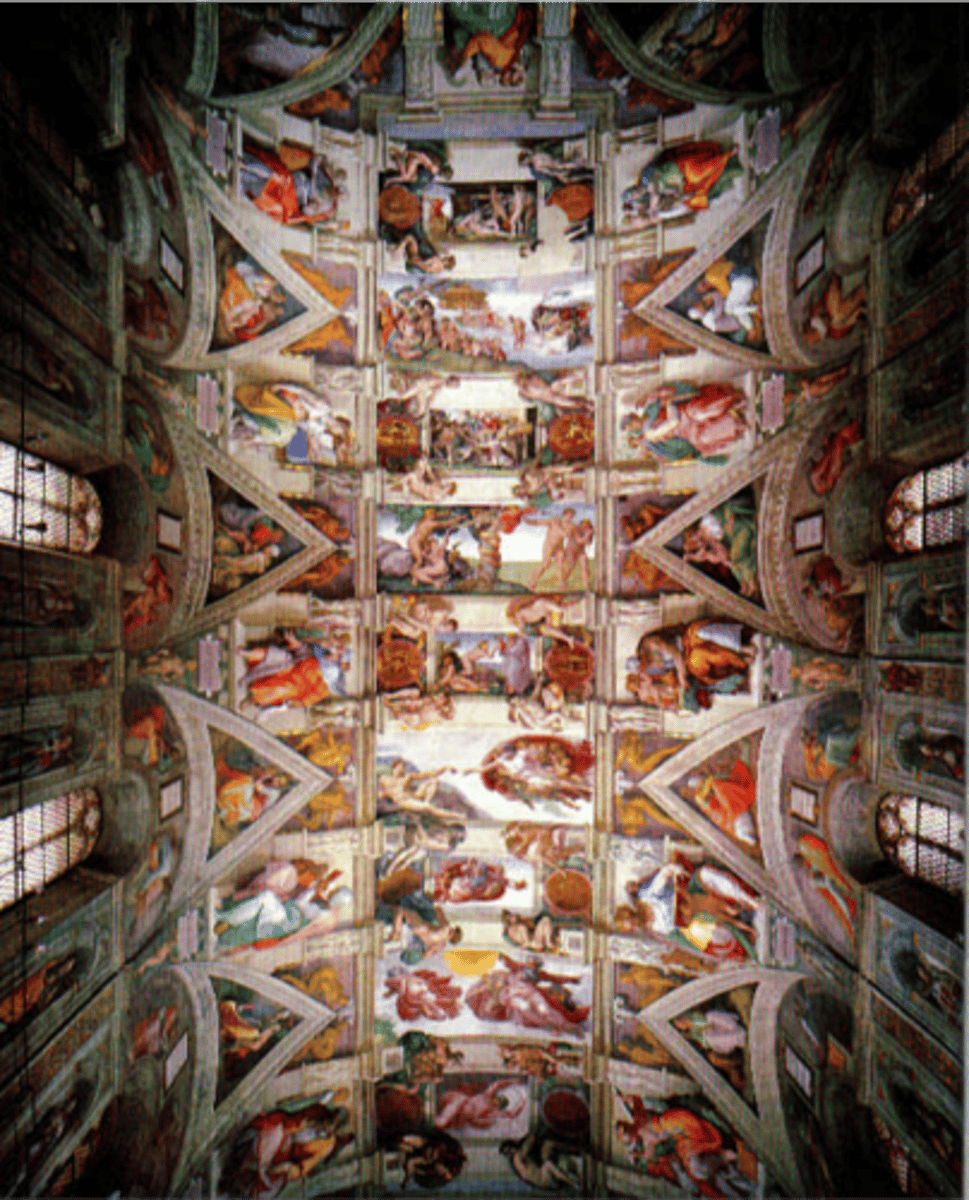
School of Athens
is one of the most famous frescoes by the Italian Renaissance artist Raphael. It was painted between 1509 and 1511 as a part of Raphael's commission to decorate the rooms now known as the Stanze di Raffaello, in the Apostolic Palace in the Vatican.
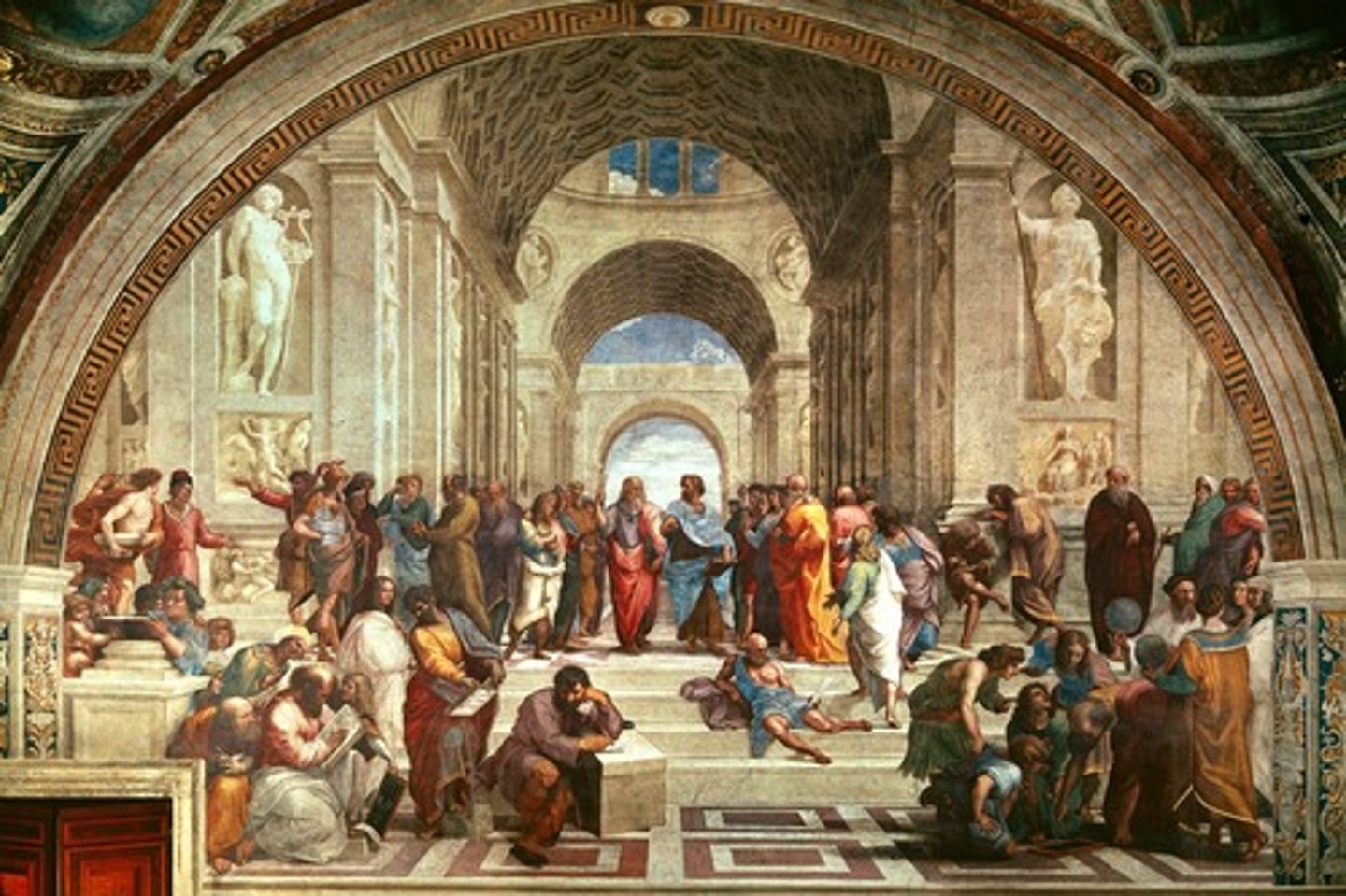
Revival of Classical Greek and Roman art forms
Humanism
Illusionistic painting techniques
Naturalistic realism
Italian Renaissance is distinguished by four defining features:
Humanism
- a belief in the nobility and dignity of humanity.
Illusionistic painting techniques
created depth, including linear perspective, foreshortening, and later, quadratura.
Naturalistic realism
m in faces and figures, further refined through oil painting techniques such as sfumato.
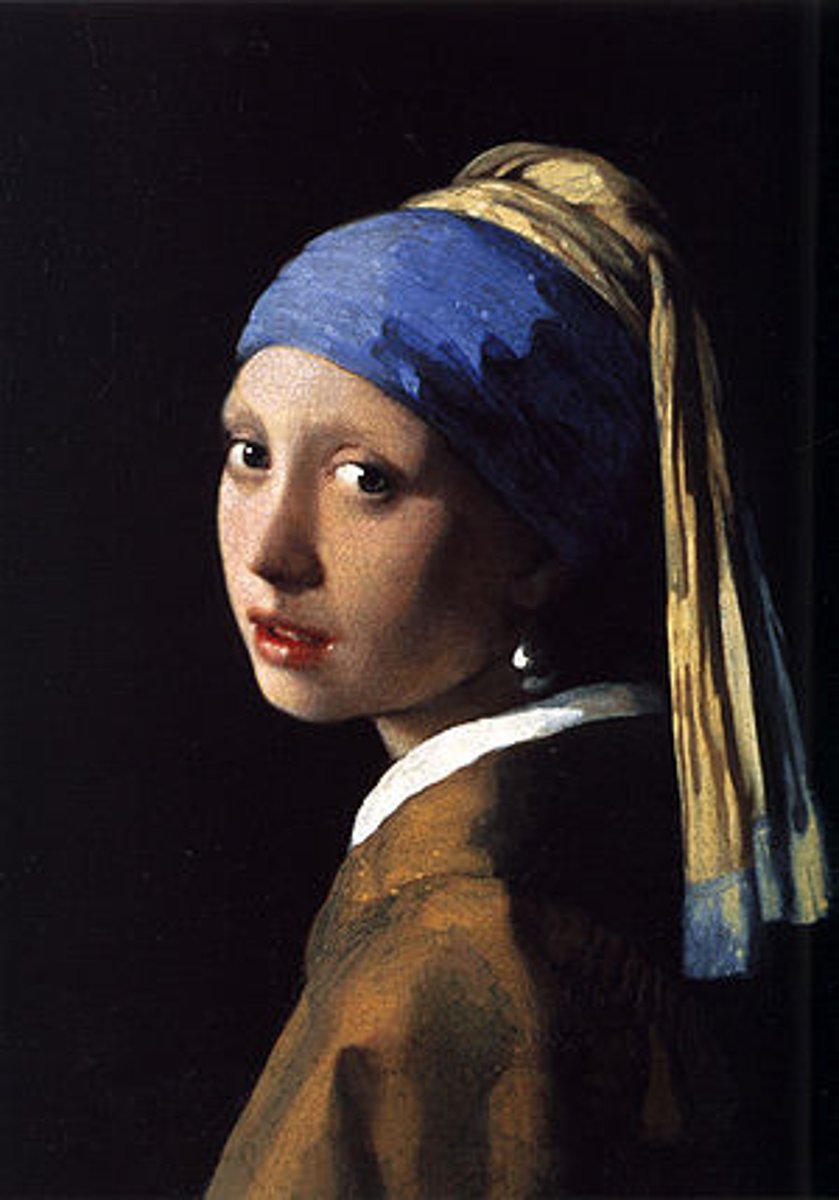
Raphael
Painter of grace and clarity. Famous for School of Athens.
Northern Renaissance
- Spread of Renaissance ideals to France, Spain, and Northern Europe.
Key artists: Jan van Eyck, Albrecht Dürer, Hans Holbein
Venetian Renaissance
Flourished in Venice with mastery of oil painting.
Artists: Titian, Giorgione.
Mannerism
- (1520-1580) (from the Italian maniera, meaning "style" or "stylishness")
- Art style after High Renaissance, characterized by artificiality, elongated bodies, twisted poses, odd perspectives, and bold colors.
- This style marked a deliberate departure from classical ideals, favoring expressiveness and stylization over naturalism.
Artists: Pontormo, Parmigianino, El Greco, Tintoretto.
- was an artistic movement in painting, sculpture, and architecture that arose in Rome and Florence between 1510 and 1520, during the late High Renaissance.
- It served as a transitional style, bridging the idealized harmony and balance of Renaissance art with the drama, movement, and theatricality of the Baroque period.
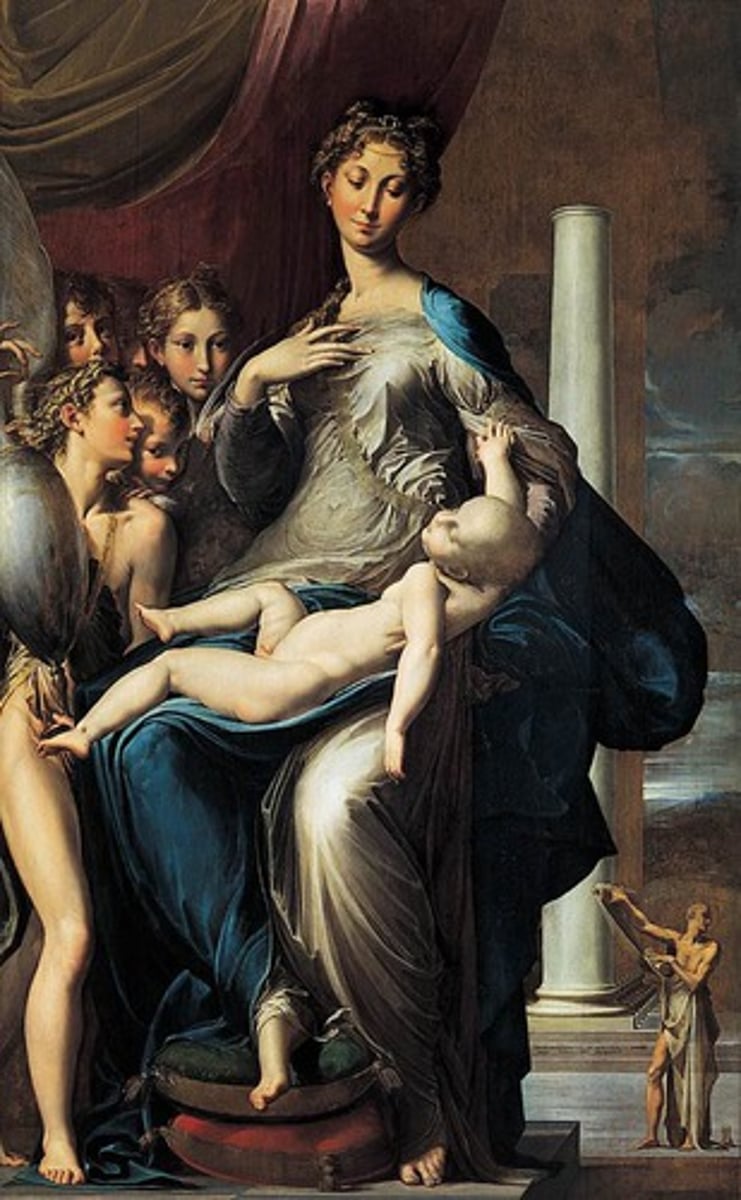
Early Mannerism
(c. 1520-1535) An "anti-classical" reaction against the harmony and naturalism of the Renaissance.
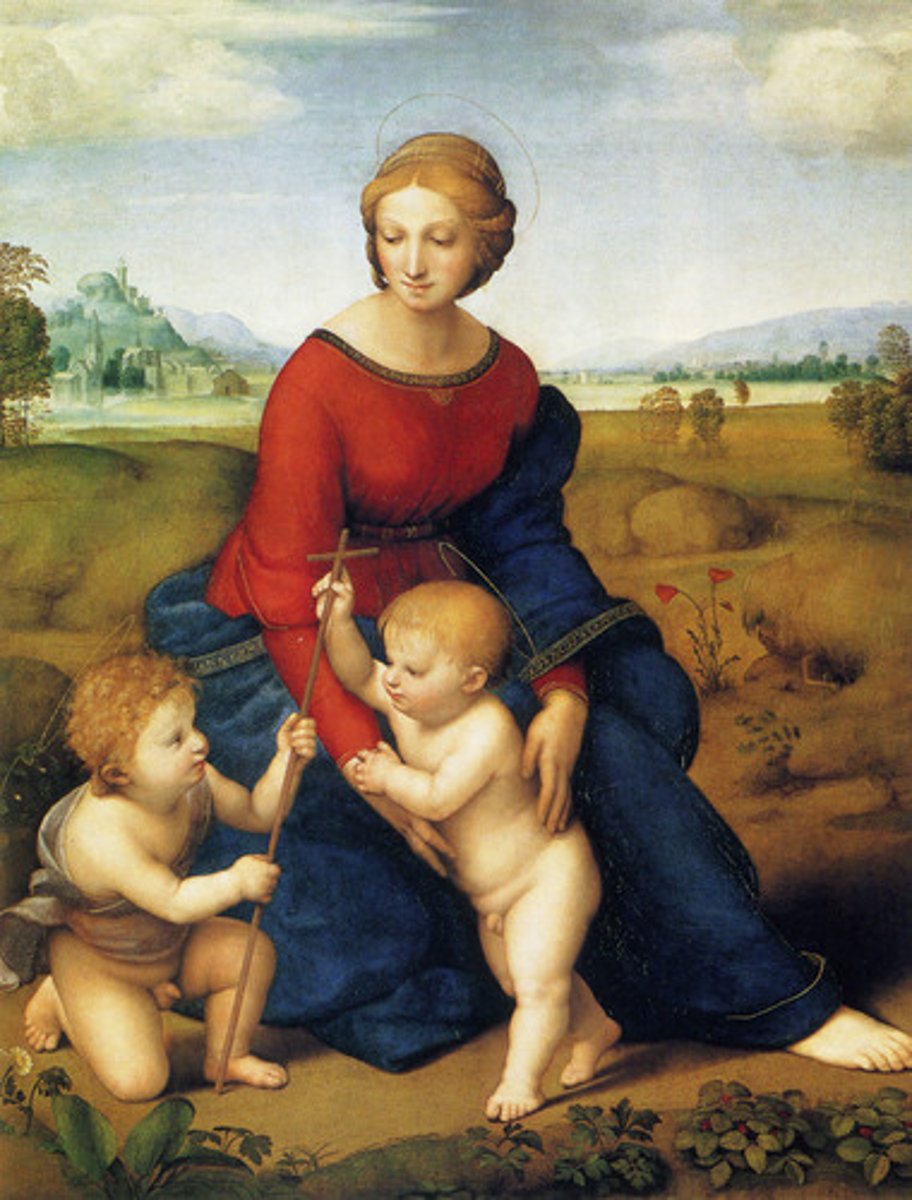
High mannerism
(c. 1535-1580): A more elaborate, intellectual style aimed at sophisticated patrons, emphasizing complexity and refinement.
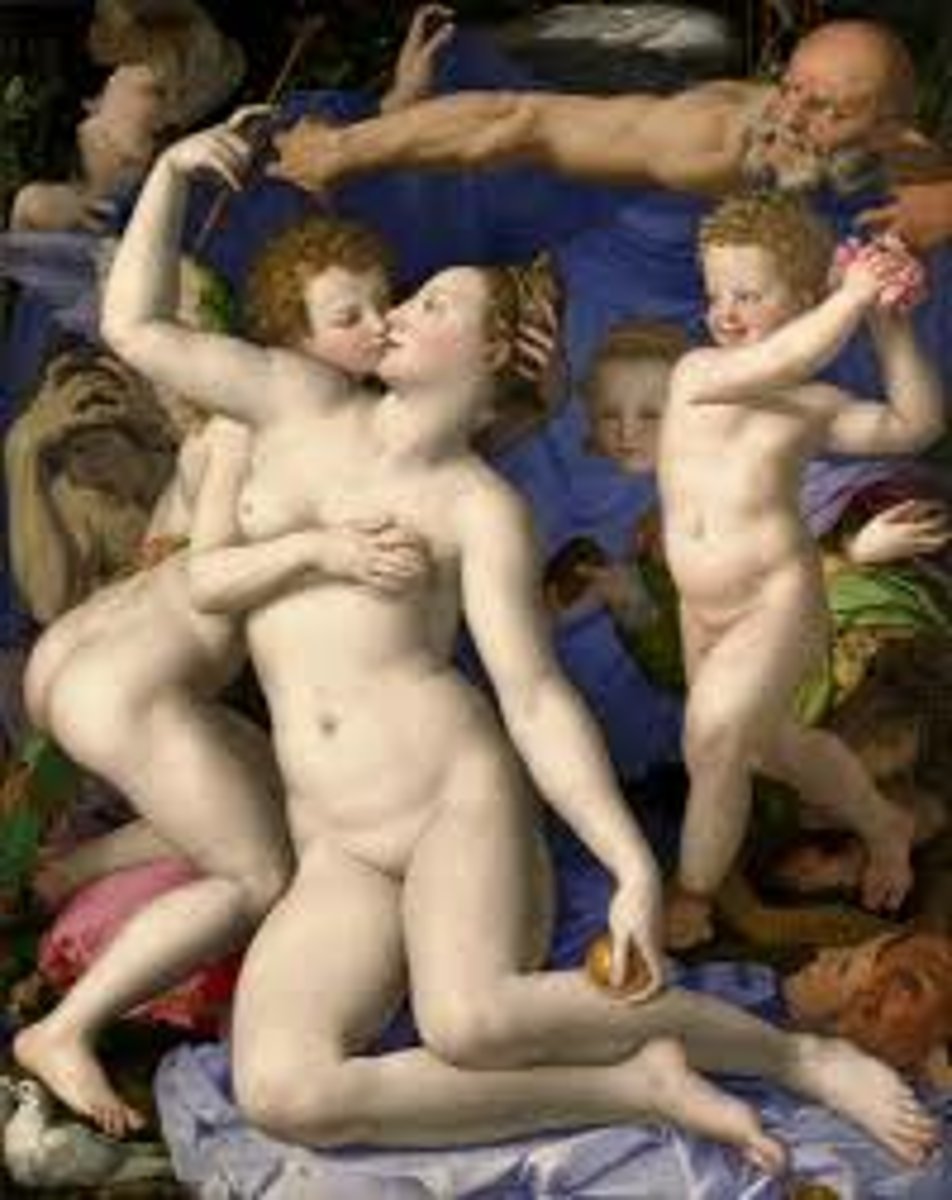
Voyages
by Magellan and Columbus confirmed the Earth's roundness and revealed Europe was not the center of the world.
heliocentric theory
displaced Earth (and thus the Church) from the cosmic center.
Martin Luther's Wittenberg Theses
- challenged the authority of the Catholic Church, particularly its corruption and the sale of indulgences. The unity of Christendom fractured, and the papacy's claims to absolute authority weakened
Jacopo Pontormo
blended influences from Leonardo, Andrea del Sarto, Raphael, and Michelangelo to create works that combined realism with otherworldliness.
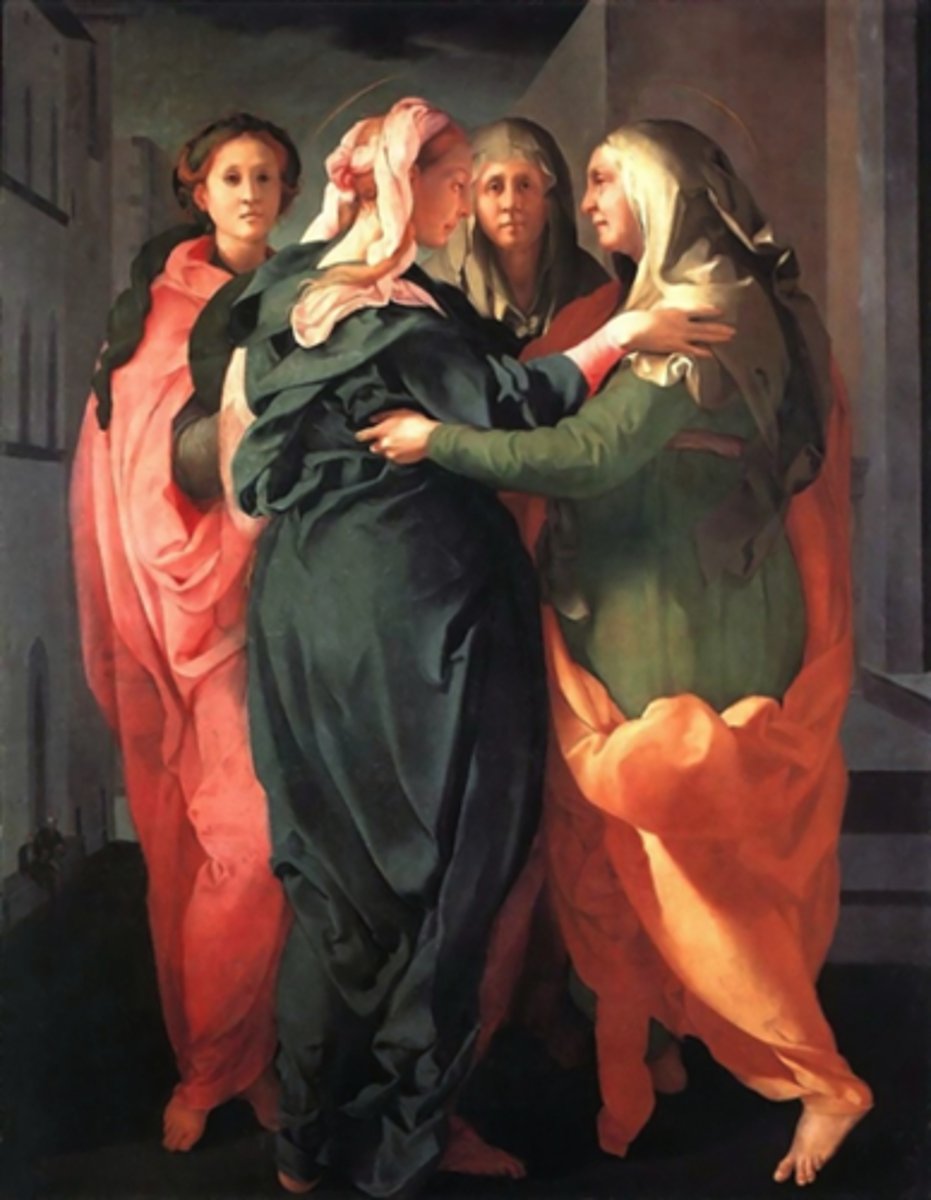
Parmigianino
in Madonna dal Collo Lungo (1535, Uffizi), created a fragmented composition with uneven pictorial weight, elongated figures, and contrasting spaces, exemplifying the tension and imbalance typical of Mannerism.
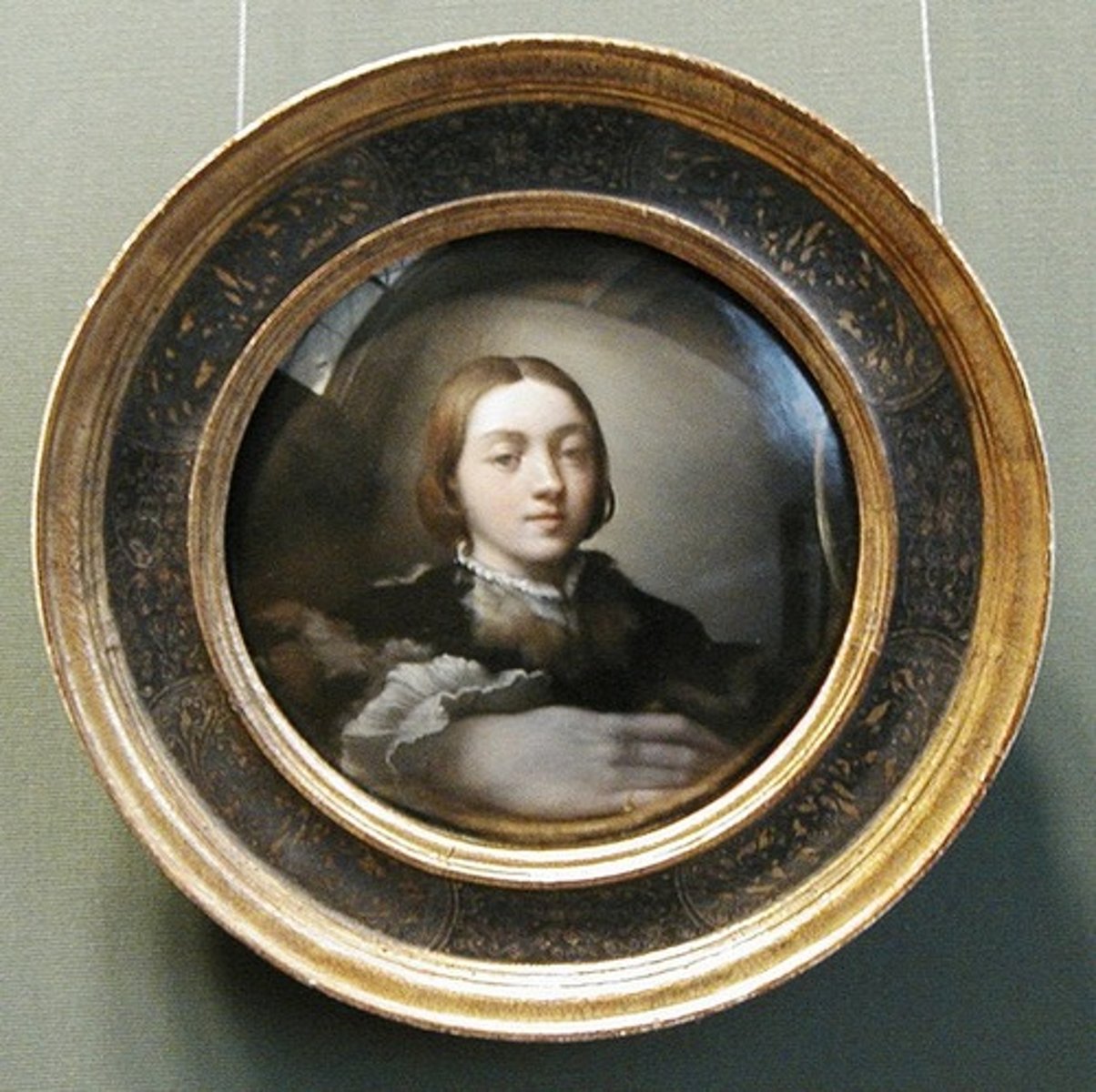
El Greco (Domenikos Theotokopoulos)
one of the greatest Mannerist painters, was rediscovered in the early 20th century as a precursor of modern artistic expression.
The Mannerist Reality
• Mannerist artists redefined the illusionistic picture space inherited from the Renaissance. Instead of merely imitating visible reality, they created an intellectual picture space—a realm expressing what was invisible, spiritual, and accessible only to the inner eye.
- This shift emphasized the artist's individual vision, making personal expression the ultimate standard of art.
•This approach directly influenced modern art, where subjective interpretation and originality became central.
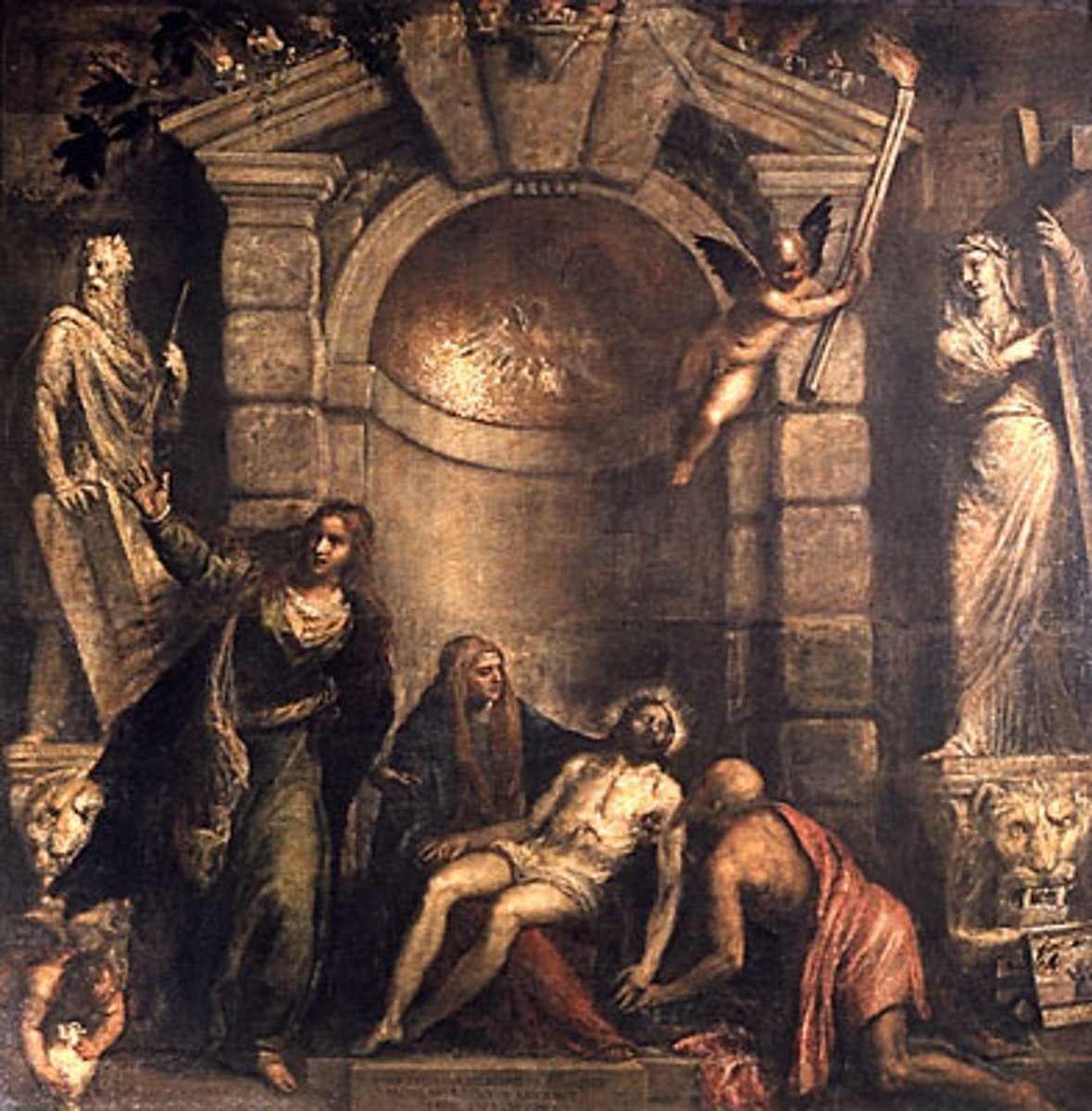
Burial of Count Orgaz
- is a painting by El Greco, a Greek painter, sculptor, and architect of the Spanish Renaissance.
- Widely considered among his finest works, it illustrates a popular local legend of his time
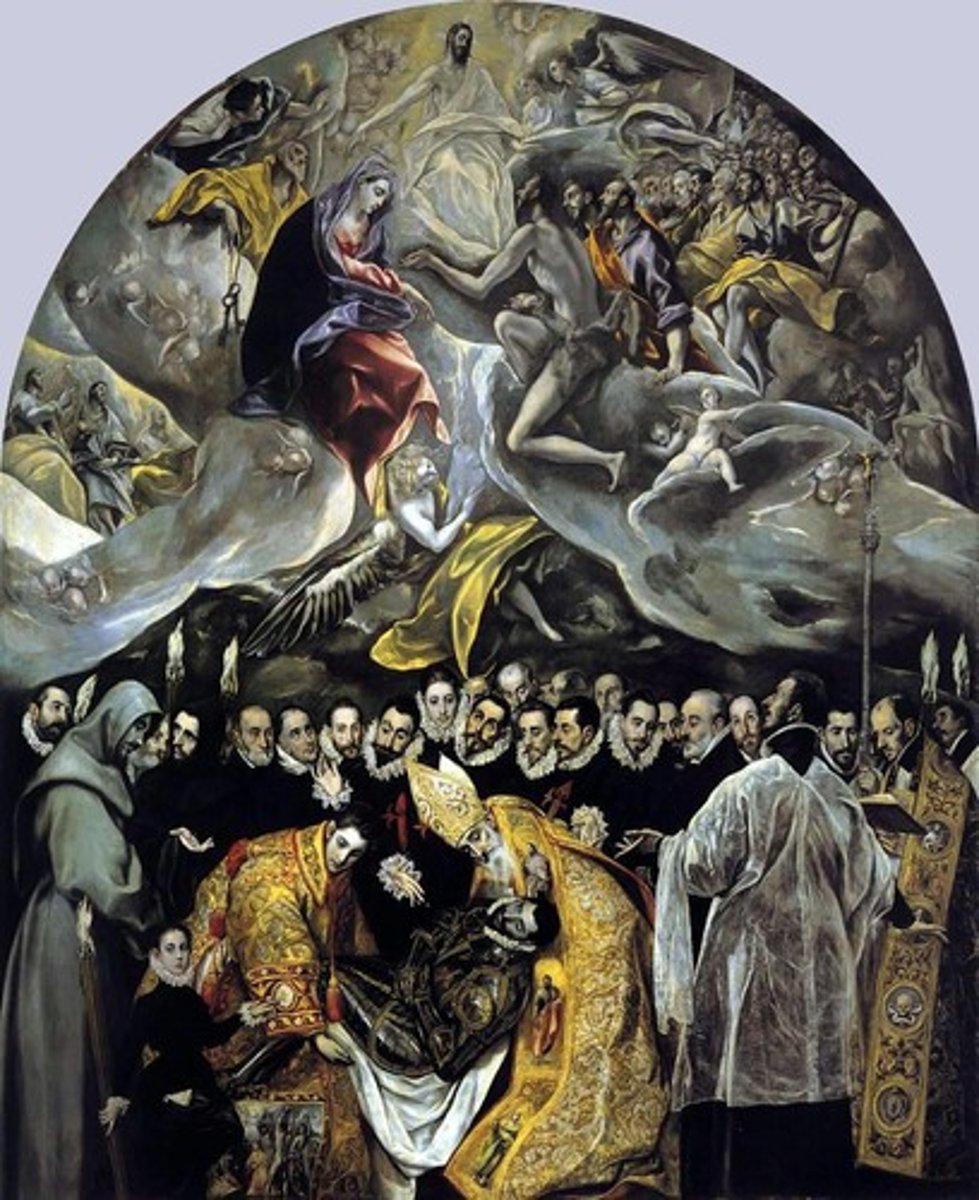
Mannerist illusionistic painting
led the movement into the Baroque from about 1600. The intellectual pictorial worlds, created by the Mannerists as early as the 16th century, reach their peak
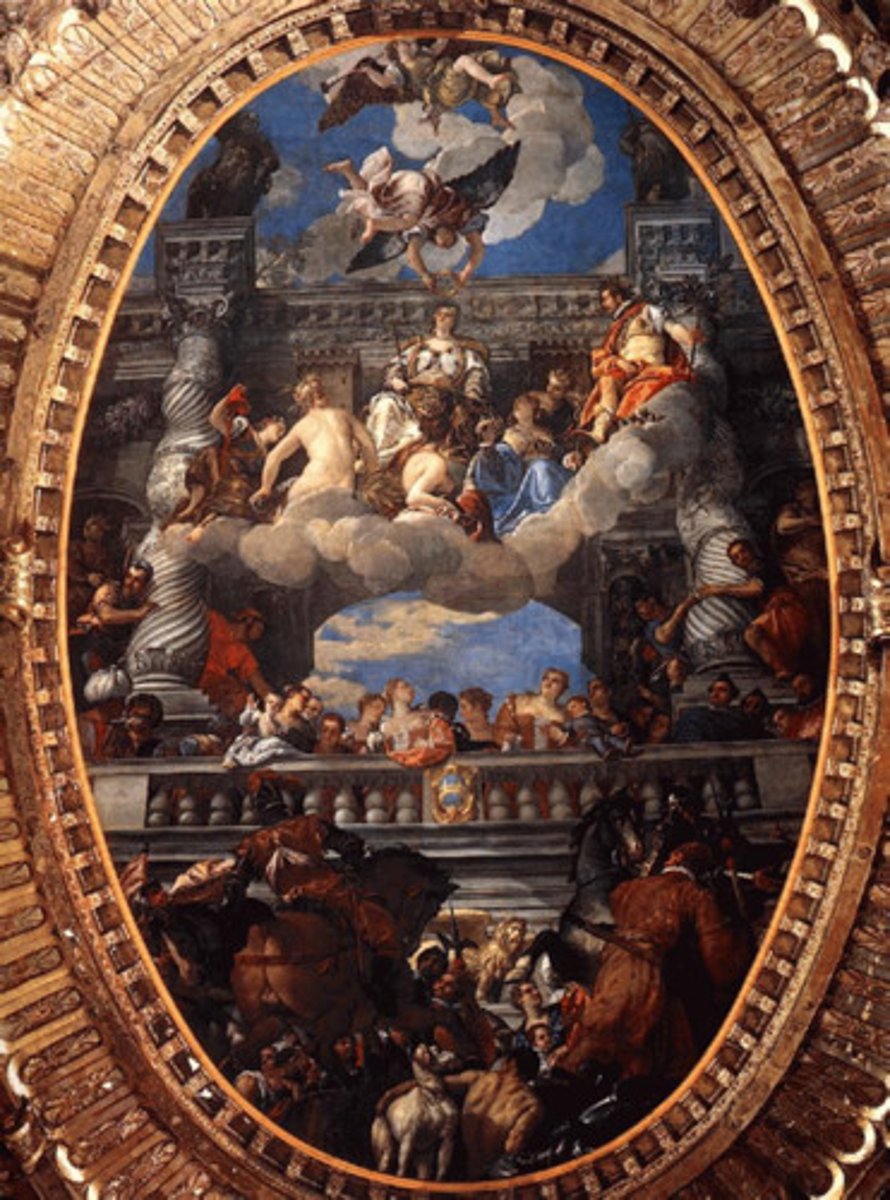
Baroque Art
(late 16th-18th century)
- Style marked by drama, grandeur, movement, intensity, and theatricality. Connected to Counter-Reformation and absolute monarchies.
- is stylistically diverse and complex, sometimes even contradictory, but it is unified by its intent to evoke strong emotions through sensory impact and dramatic presentation
Key qualities of Baroque art include:
• Grandeur and magnificence
• Sensuous richness
• Drama, vitality, and movement
• Emotional intensity and exuberance
• Dynamic tension
• Blurring of boundaries between the arts (painting, sculpture, architecture, and music often combined for immersive effect)
- were marked by diversity and coexistence of different styles, as naturalism and classicism intermingled with the dramatic tendencies of the era.
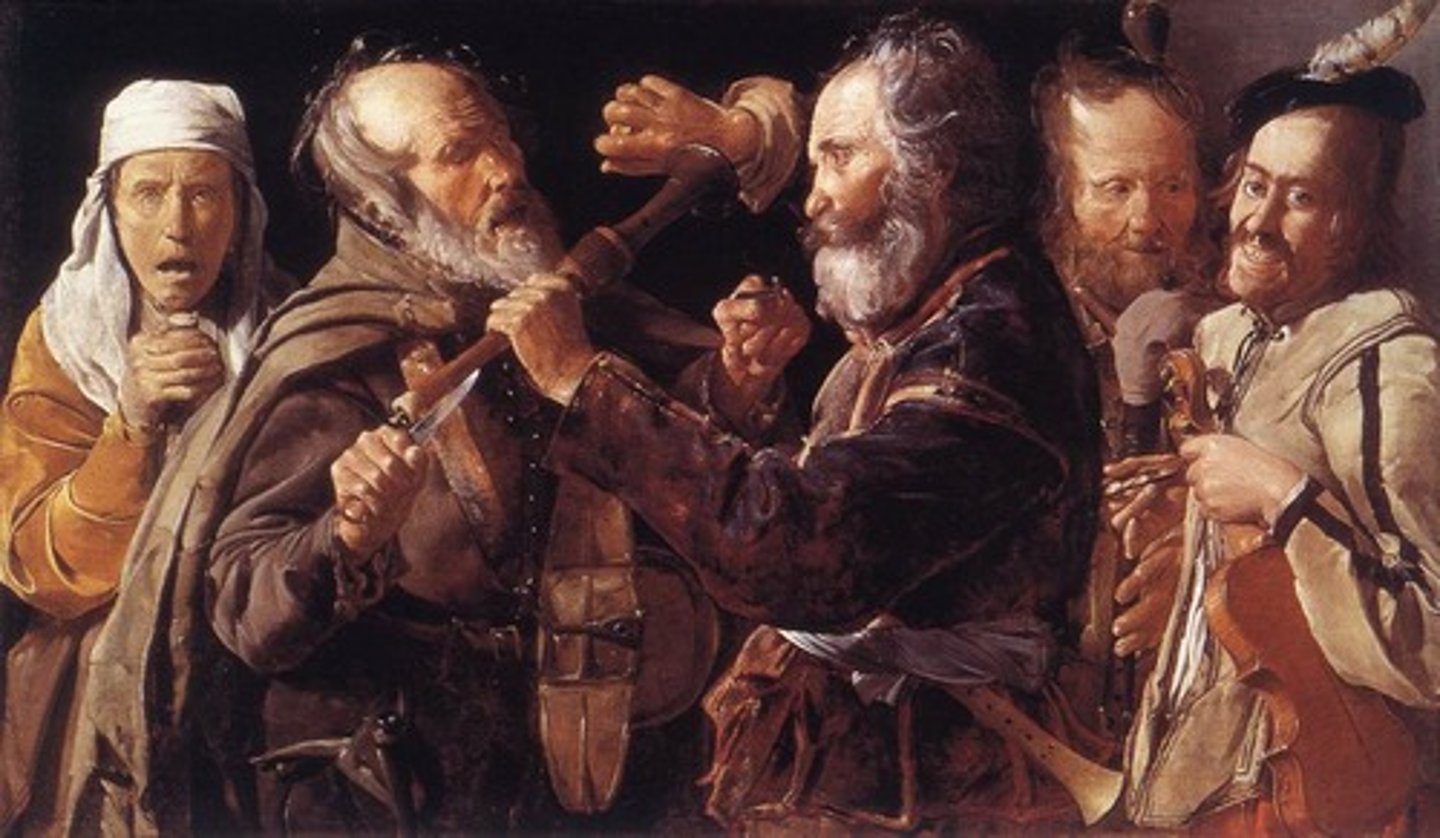
barocco
Italian word, used in the Middle Ages to describe convoluted or problematic logical reasoning.
barroco/barrueco
The Portuguese/Spanish word, referring to an irregularly shaped pearl, a meaning still preserved in the jeweler's term baroque pearl.
Heinrich Wölfflin's landmark study Renaissance und Barock (1888)
- The word "Baroque" was redefined as a legitimate stylistic category.
- He systematically outlined its characteristics, transforming the term from one of dismissal to one of recognition and scholarly value.
The Counter-Reformation (Catholic Revival)
Following the Council of Trent (1545-1563), the Catholic Church embraced art as a tool of propaganda and devotion, using it to inspire faith and engage the senses. Religious art became at once sensuous and spiritual: naturalism made sacred images accessible, while dramatic, illusionistic effects (such as painted ceilings opening to heavenly visions) were used to evoke awe and reinforce divine grandeur.
Absolute Monarchy and Rising Middle Class
The growth of centralized monarchies led rulers to use monumental palaces and grand architecture as symbols of state power and authority. At the same time, a powerful middle class emerged as significant art patrons.
Palace of Versailles
in France exemplifies the Baroque ideal of royal magnificence and political symbolism.
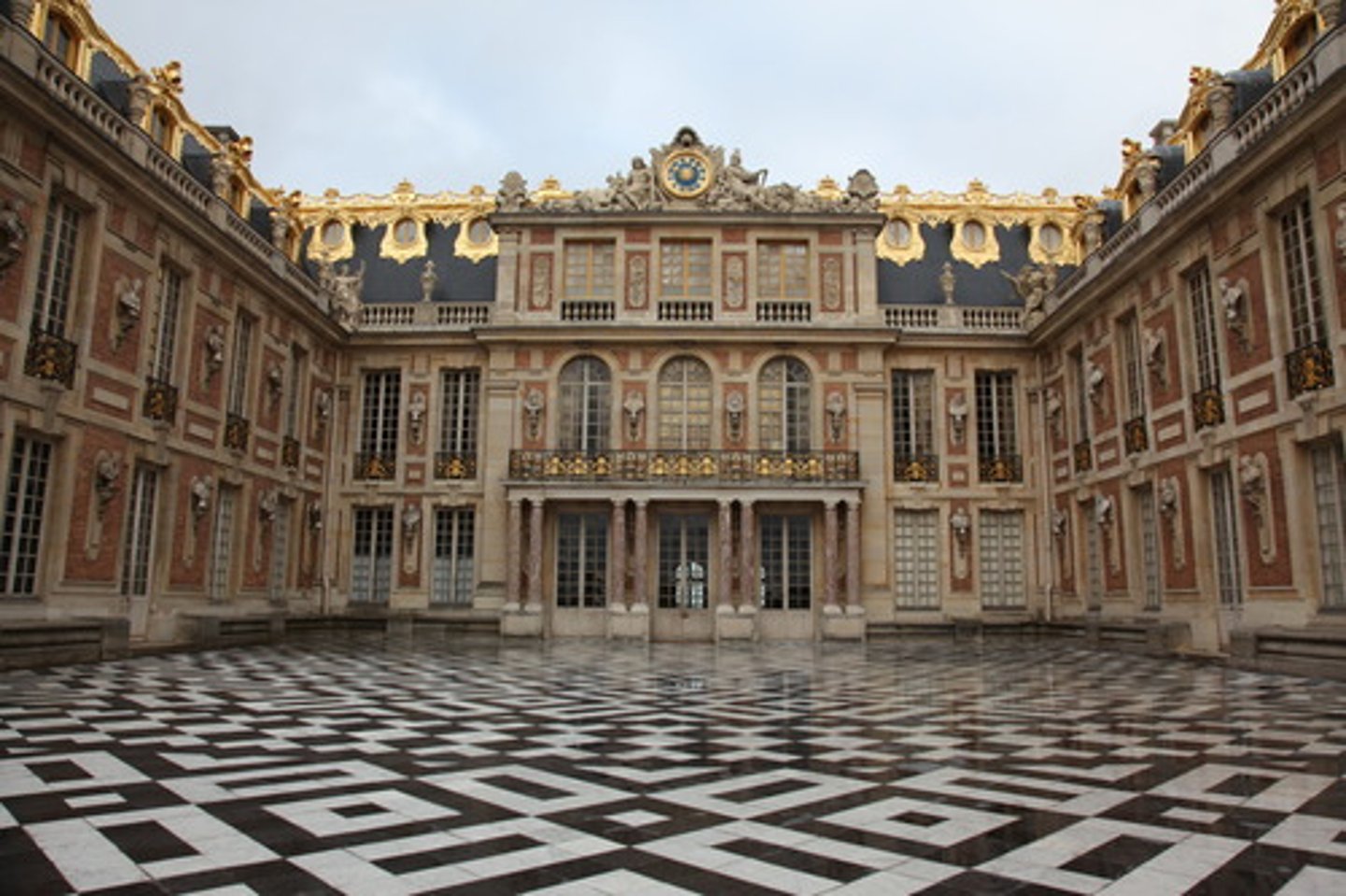
Scientific and Intellectual Expansion
Discoveries in science (such as Copernicus's heliocentric theory) and global exploration widened intellectual horizons
The Counter-Reformation (Catholic Revival)
Absolute Monarchy and Rising Middle Class
Scientific and Intellectual Expansion
(3) Three Main Tendencies of the Baroque Er
Caravaggio
(1571-1610), Italian painter known for realism and dramatic chiaroscuro
Annibale Carracci
(1560-1609) Baroque painter with classical style, contrast to Caravaggio.
Baroque painting style
- developed in Rome, characterized by monumental ceiling frescoes and theatrical religious imagery.
Key artists included Pietro da Cortona, Guido Reni, Il Guercino, and Domenichino, whose works emphasized grandeur, movement, and dramatic use of light.
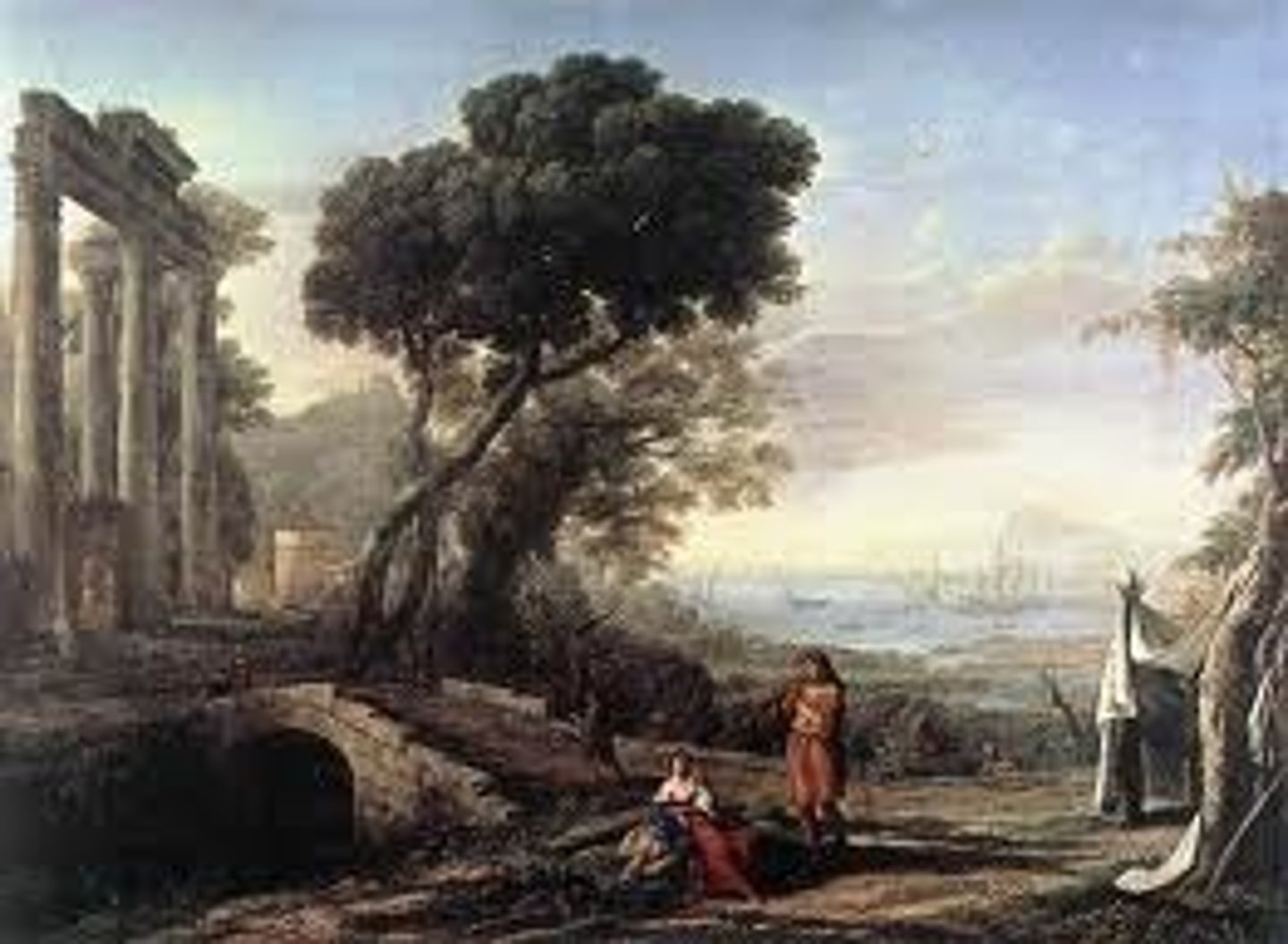
Gian Lorenzo Bernini
(1598-1680) who fused art and architecture to create awe-inspiring religious spaces.
His masterpieces include the Baldachin of St. Peter's Basilica (spiral columns over the altar) and the colonnade of St. Peter's Square, designed to embrace the faithful.
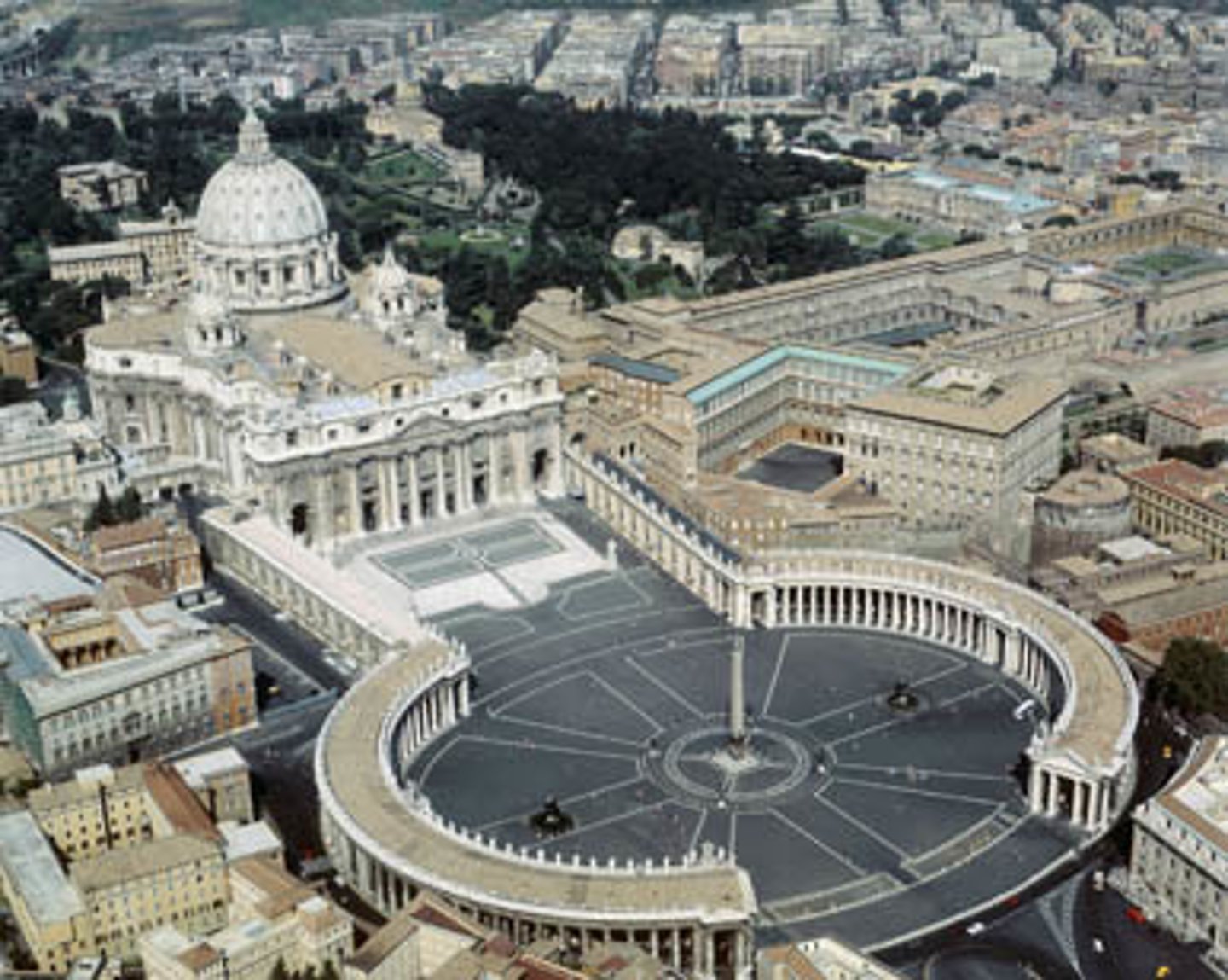
Peter Paul Rubens
- whose dynamic diagonal compositions and full-bodied, energetic figures epitomized Baroque painting.
- Flemish Baroque painter known for dynamic, emotional, and colorful works.
Anthony van Dyck
- known for his refined portraits influenced by Peter Paul Rubens.
- Student of Rubens; famous for elegant portraits.
Jacob Jordaens
who created robust figurative works in Rubens's spirit. Influenced by Paul Rubens
The Netherlands (Dutch Republic)
Baroque had less impact due to the middle-class Protestant culture, which favored realism and secular subjects over religious grandeur.
Churriguera Family
(Spain)
- Architects of the ornate Churrigueresque Baroque style.
Dutch art
flourished in genre scenes, landscapes, and portraits, with masters like Rembrandt and Frans Hals shaping a distinctive national style that remained largely independent of Baroque principles.
Rococo Art
- emerged in early 18th-century Paris, reflecting a shift from the grandeur of Baroque to a lighter, more intimate style.
- It is characterized by soft pastel colors, curving lines, and playful themes, often depicting love, nature, youth, courtly pleasures, and lighthearted entertainment.
- n emphasized grace, elegance, intimacy, and charm, creating spaces filled with delicate ornamentation and paintings that celebrated daily life, romance, and leisure.
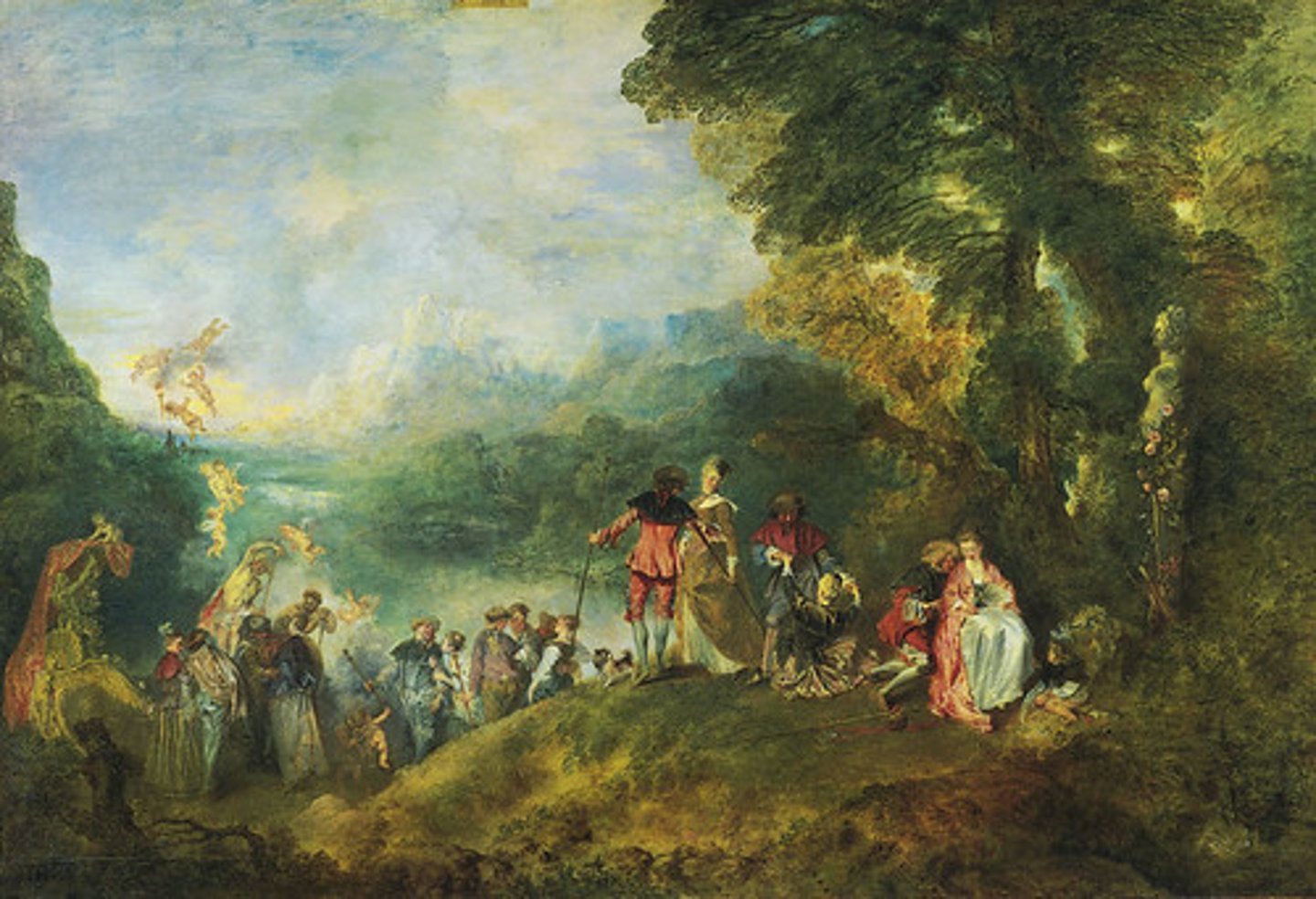
rococo
comes from the French word rocaille (meaning rubble or rock), originally referring to the shell-like ornamentation and serpentine motifs common in garden grottoes and decorative arts of the period
Rococo design
- s were typically plain and restrained, but their interiors exploded with lavish ornamentation, creating an atmosphere of theatrical splendor.
- sought to awe and delight, using elaborate decorations, interlocking oval floor plans in churches, and grand staircases in palaces that offered multiple viewpoints of the richly adorned spaces (Hopkins, 2014)
Jean Honoré Fragonard
- one of the movement's most notable painters, produced works full of charm, intimacy, and wit.
- Although underappreciated during his lifetime, he is now celebrated for works such as La coquette fixée (The Fascinated Coquette), which portrays a flirtatious encounter between a woman and two men.
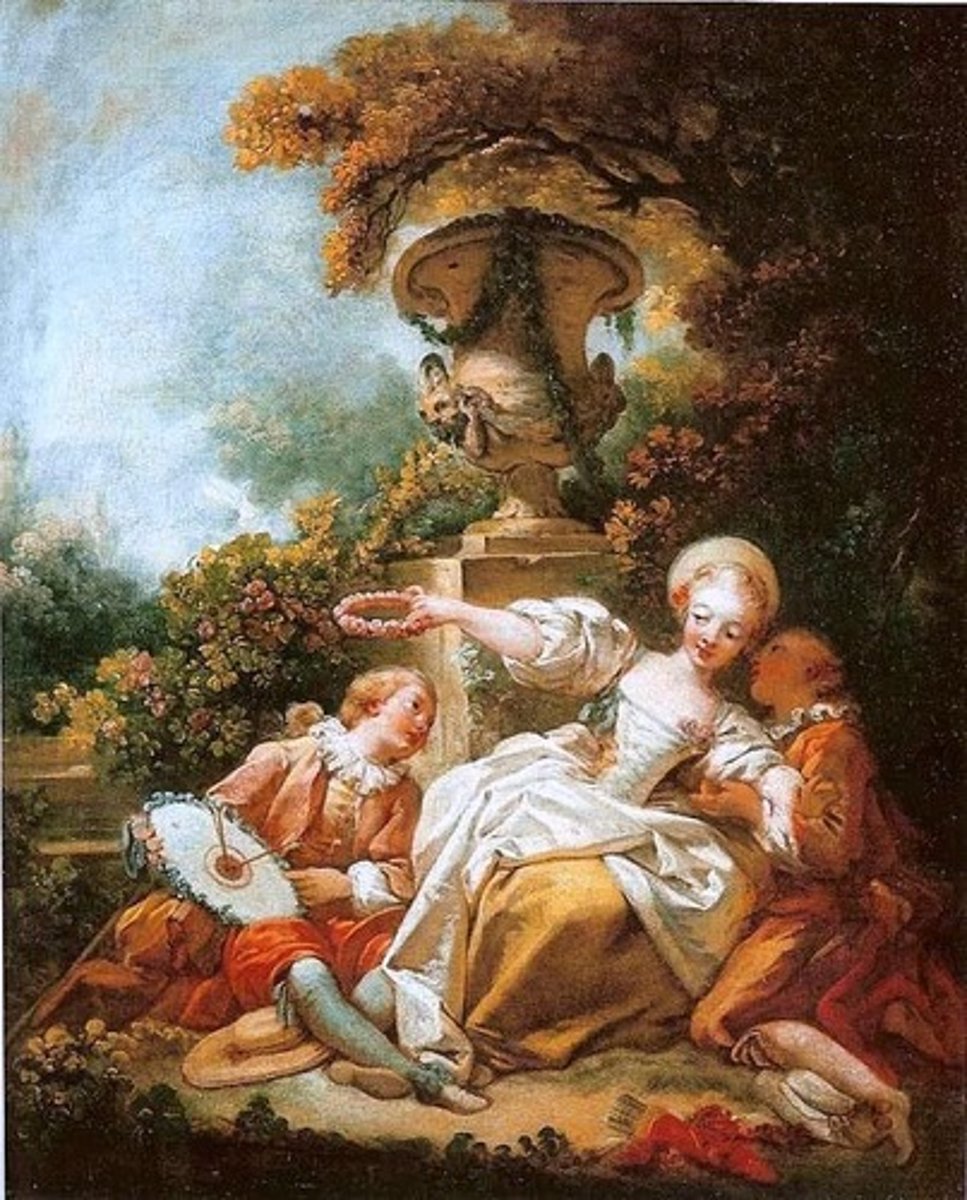
Rococo sculpture and porcelain
- evolved from the dramatic Baroque tradition but became lighter, more graceful, and infused with playful movement.
- emphasized ornamentation, asymmetry, pastel colors, curving lines, and playful subjects, representing the refined yet decadent lifestyle of the French aristocracy.
- Religious works, such as the Karlskirche altarpiece in Vienna, retained theatricality and focused on romantic, mythological, and sentimental themes, often commissioned by patrons like Madame de Pompadour, the influential mistress of Louis XV.
- French sculptors such as Edmé Bouchardon (e.g., Cupid Carving His Darts), Étienne-Maurice Falconet, Jean-Louis Lemoyne, Jean-Baptiste Lemoyne, Louis-Simon Boizot, Michel Clodion, and Pigalle embodied this spirit of delicacy and sensuality. In Italy, Antonio Corradini became famous for his veiled female figures, blending technical brilliance with emotional subtlety.
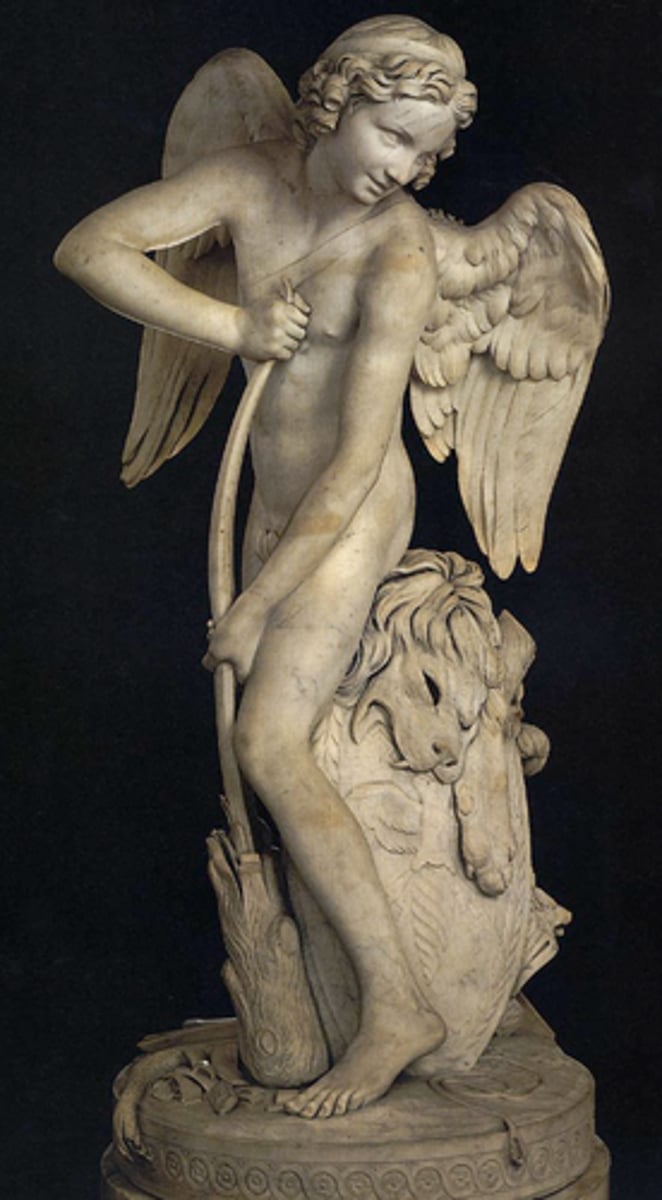
Franz Anton Bustelli
(Nymphenburg Porcelain Manufactory, Bavaria) and Falconet (as director of the Sèvres Porcelain Manufactory) produced charming figurines that reflected Rococo ideals of love, joy, and aristocratic leisure
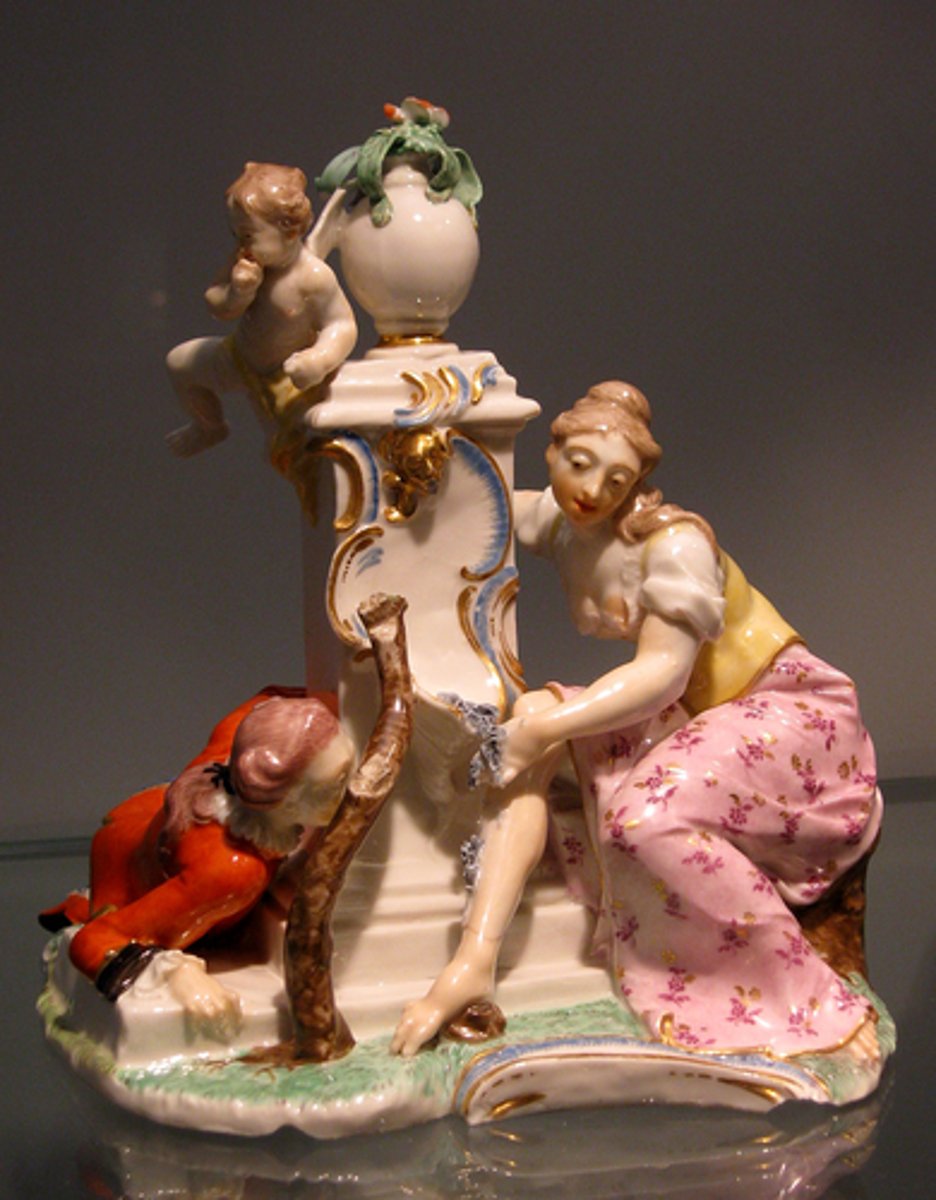
Rococo fashion
- embodied extravagance, elegance, refinement, and decorative excess, mirroring the artistic style of the 18th century.
- Known at the time as le style rocaille, le style moderne, or le goût, emphasized graceful curves, elaborate fabrics, and luxurious ornamentation
- Unlike the more restrained fashions of the 17th century, the dresses were ornate, sophisticated, and playful, aligned with the Enlightenment's cultural shift from Versailles to Paris.
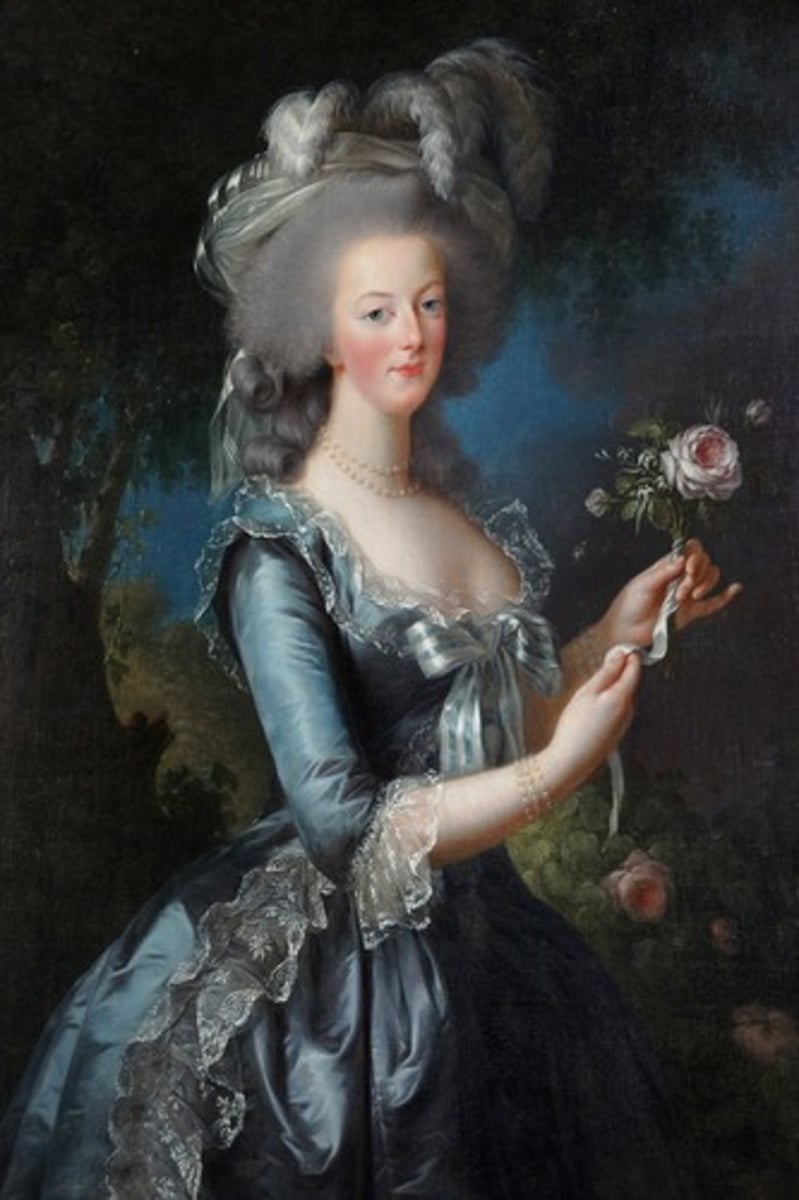
Early Rococo fashion
favored rich, dark fabrics with heavy embellishment, though later fashions shifted toward lighter colors and more delicate designs in keeping with the overall Rococo aesthetic
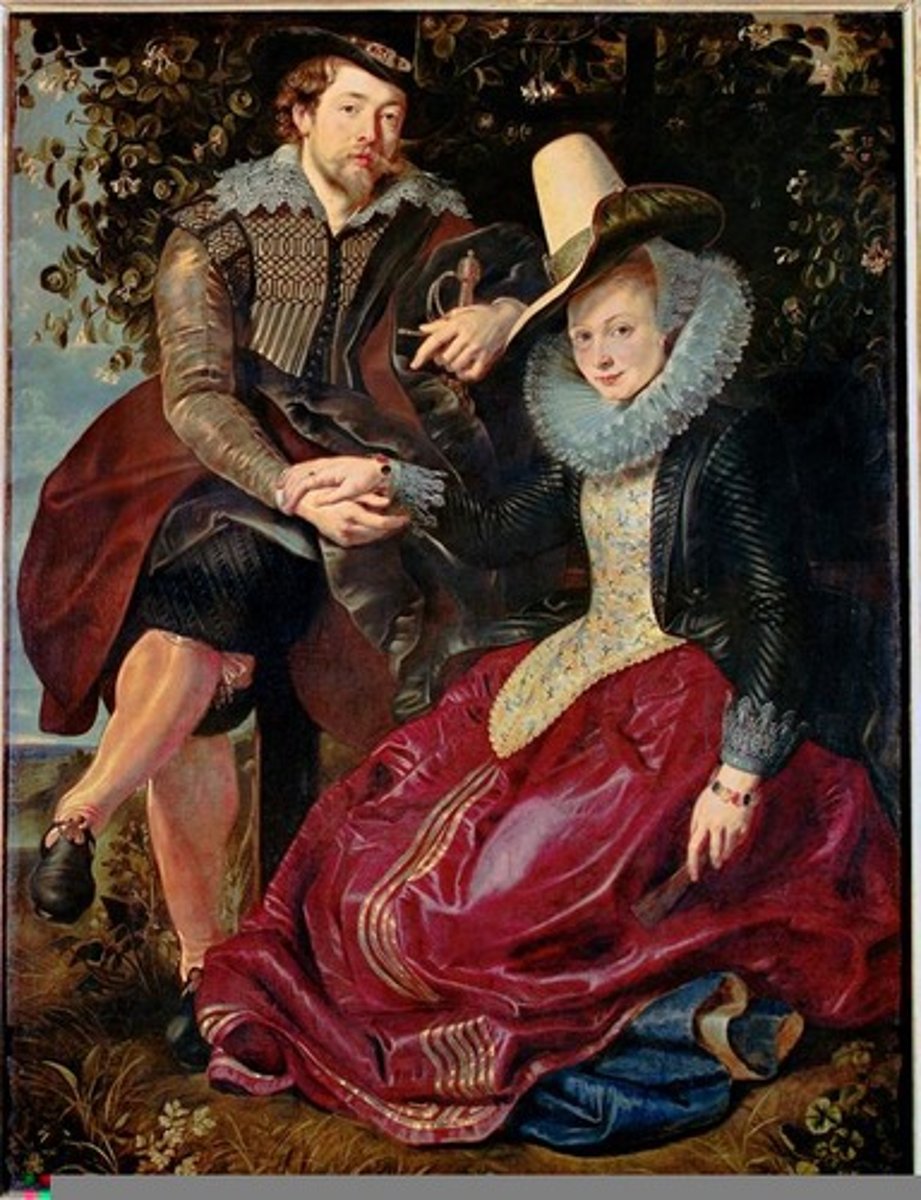
Neoclassicism
- was an 18th-century artistic movement that sought to revive and emulate the ideals of ancient Greece and Rome as well as the spirit of the Renaissance.
•Known as the Classical Revival in modern art. •Key figures: Pablo Picasso, Fernand Léger, and Giorgio de Chirico, who reinterpreted classical forms within modernist movements
- This movement extended across all the arts—painting, sculpture, architecture, decorative arts, literature, music, and theater—and was characterized by straight lines, restrained colors, and balanced forms that reflected classical values of harmony and proportion.
- Reaction against Rococo. Revival of Greek & Roman classical ideals, emphasizing simplicity, order, and rationality.
Inspired by the Enlightenment. Artists: Jacques-Louis David, Jean-Auguste-Dominique Ingres.
- revived the discipline, order, and moral seriousness of antiquity, rejecting Baroque grandeur and Rococo frivolity.
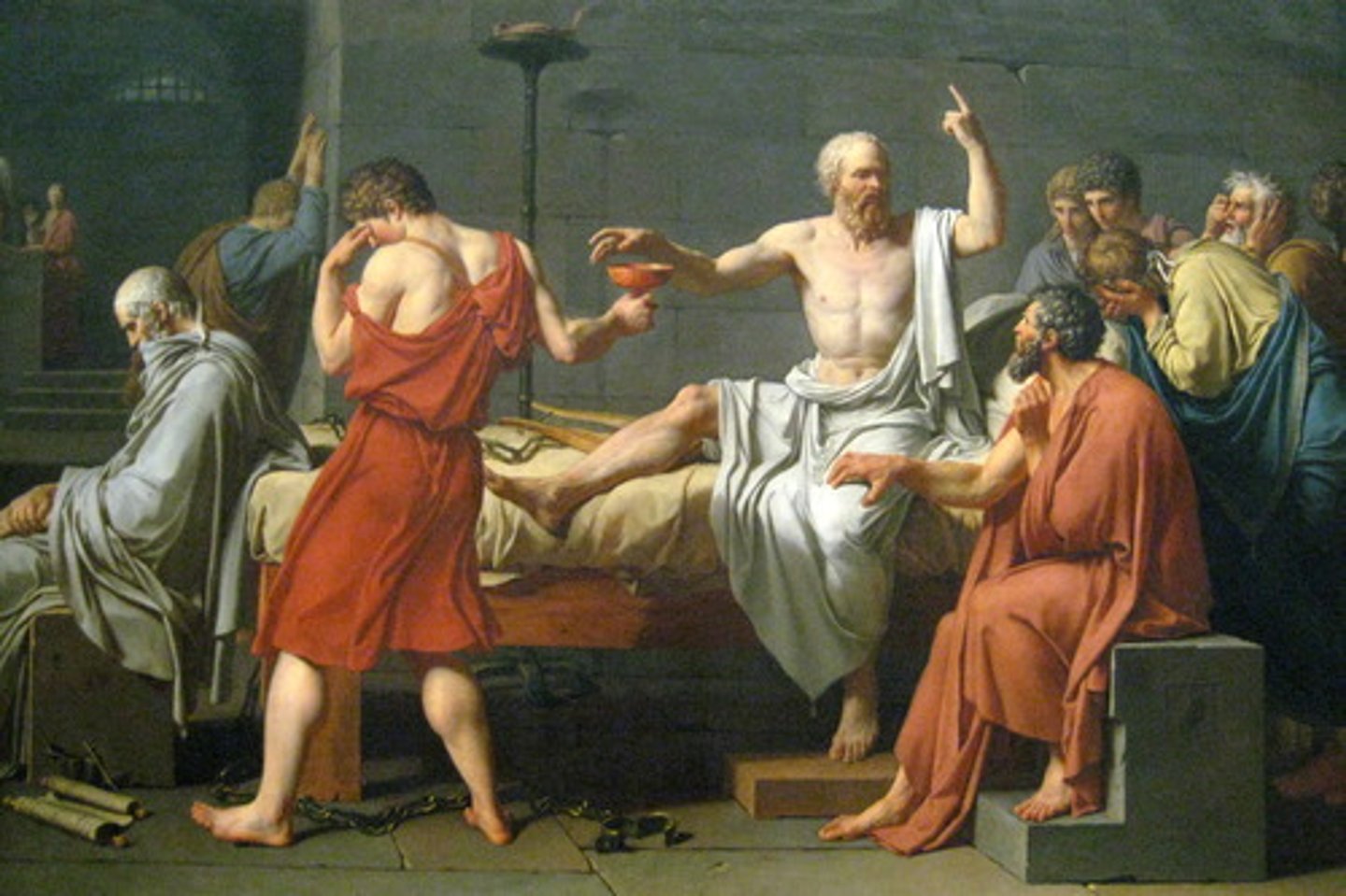
Johann Joachim Winckelmann
A major influence on neoclassicism was the founder of modern archaeology and art history. •He praised Greek art as the highest form of beauty and perfection, inspiring artists to turn toward antiquity as their model.
Jean-Auguste-Dominique Ingres
- (1780-1867): A leading French painter, Ingres is known for works such as Oedipus and the Sphinx (1808), which directly referenced themes from Sophocles' classical plays.
- His art emphasized clarity, precision, and classical subject matter, embodying the intellectual seriousness of Neoclassicism
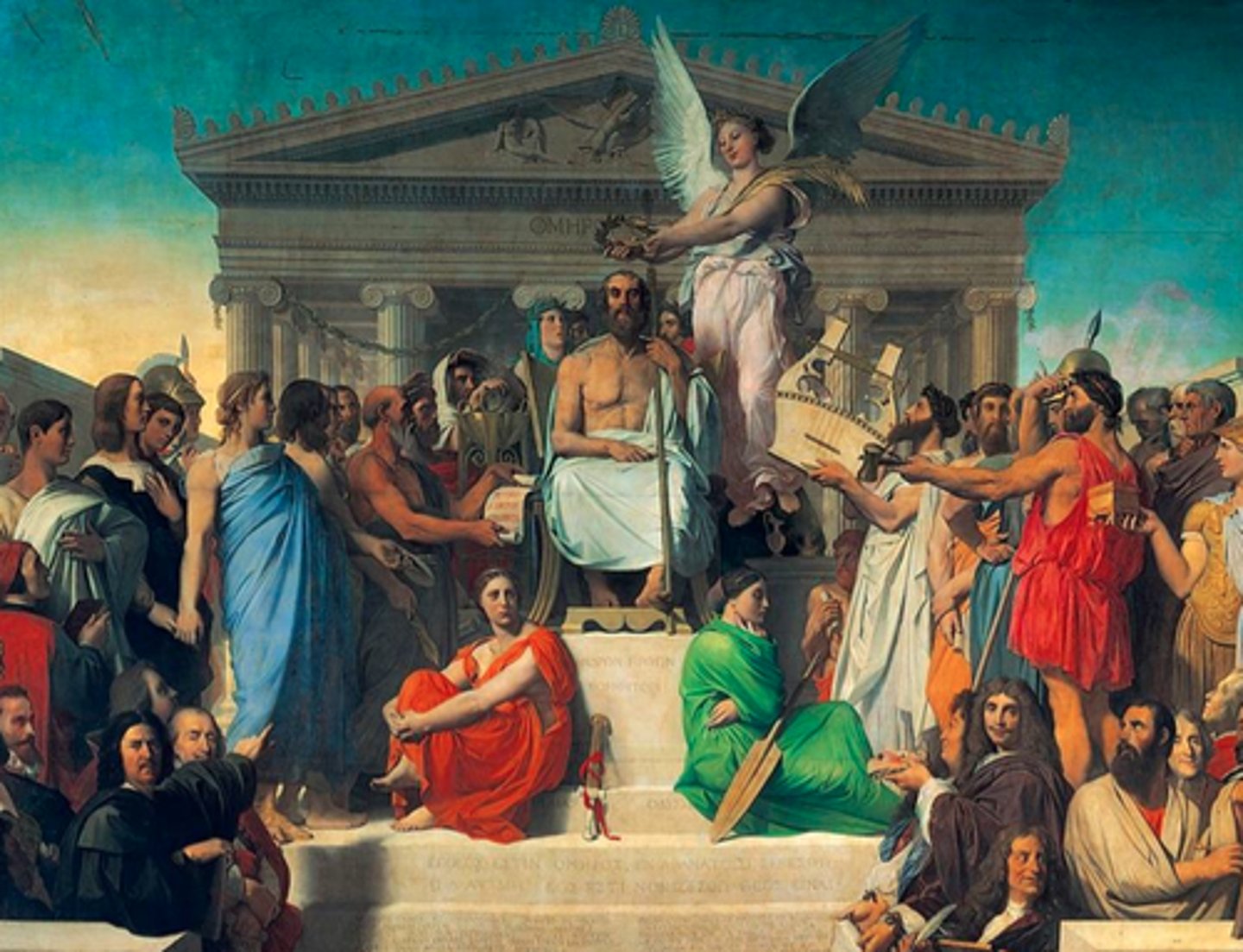
Josiah Wedgwood
(1730-1795)
- A British ceramic manufacturer and founder of the famous Wedgwood Company (1759), he revolutionized decorative arts by producing jasperware, creamware, and black basalt ceramics.
- His works featured simple geometric forms and frieze-like decorations inspired by ancient Greek and Roman pottery, making classical style accessible to broader audiences
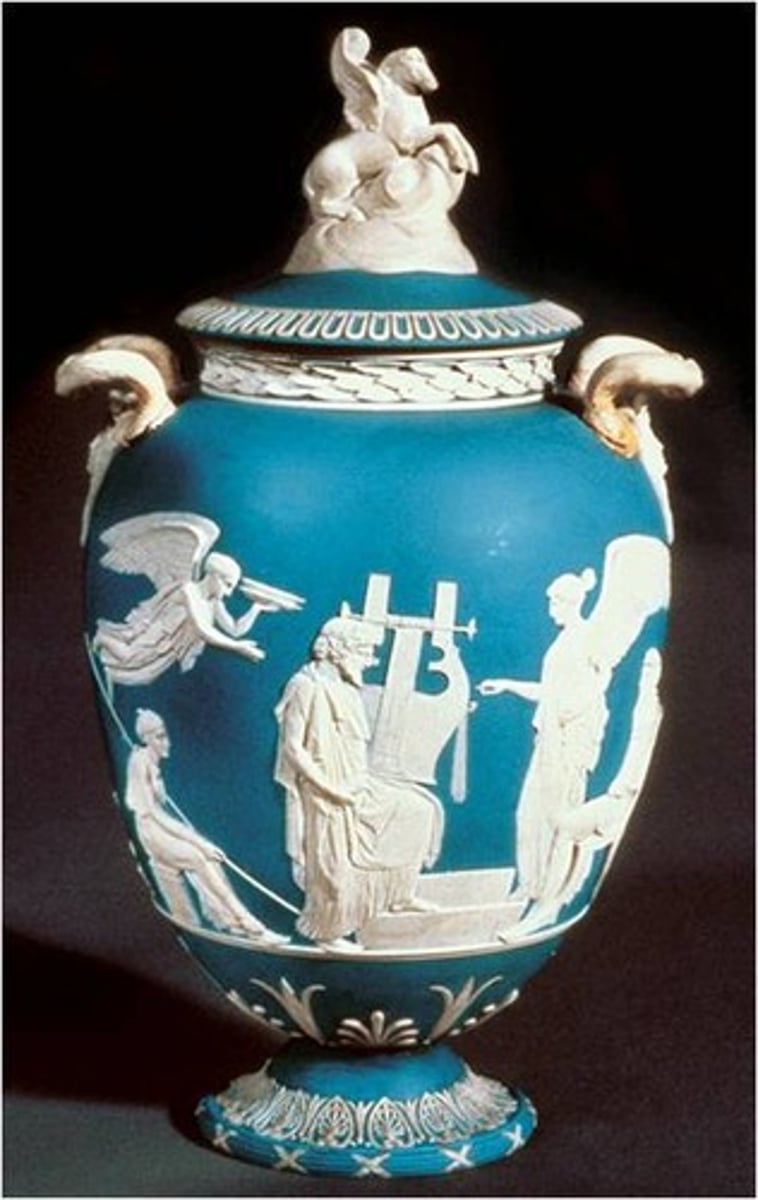
jacques-Louis David
(1748-1825)
became the hallmark of the Neoclassical style, with themes of patriotism, civic duty, and moral seriousness that reflected Enlightenment ideals.
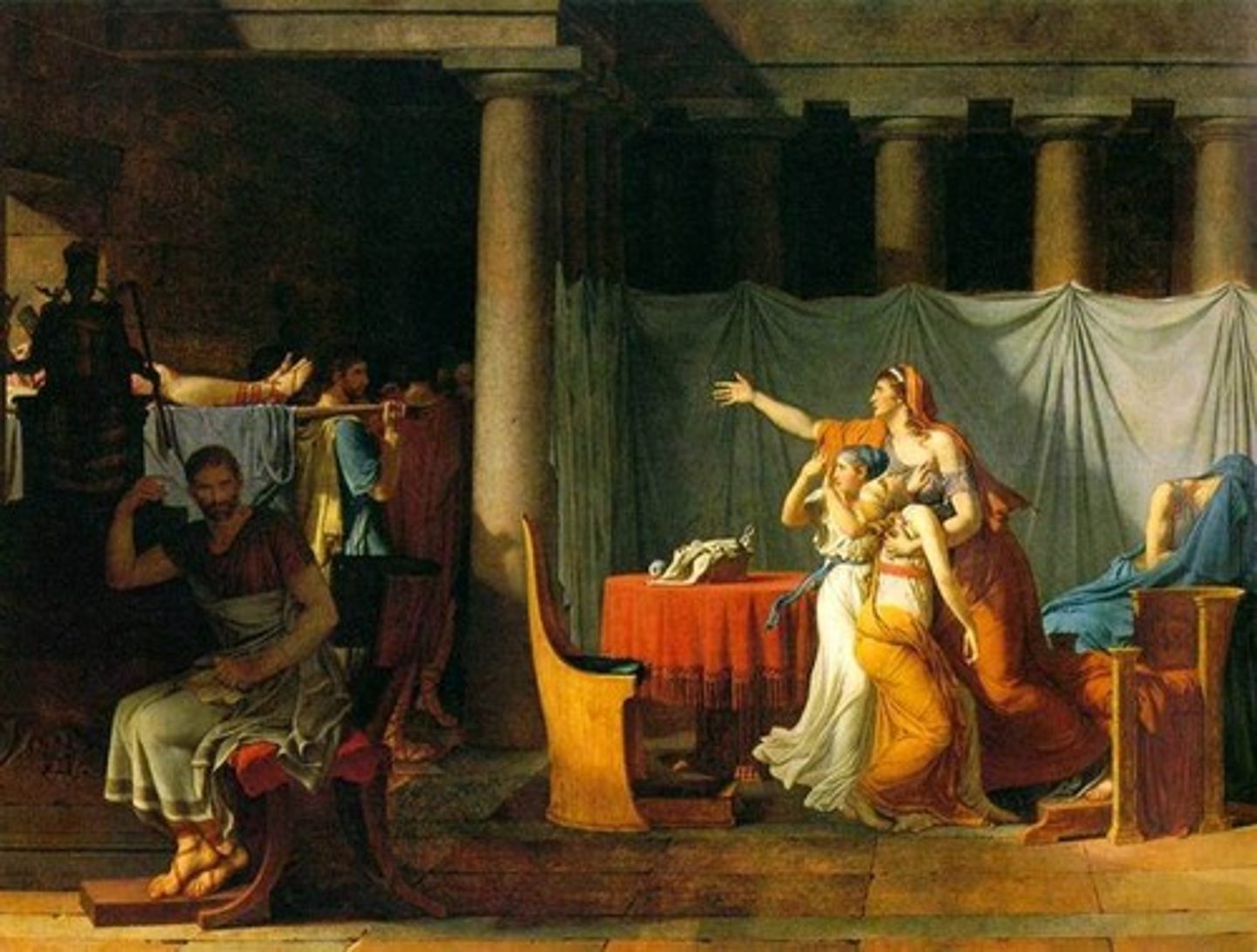
Famous Neoclassical Buildings
Buckingham Palace, London
Arc de Triomphe, Paris
Pavlovsk Palace, Russia
Pantheon, Paris
Tegel Palace, Berlin
Brandenburg Gate, Berlin
7 Characteristics of Neoclassicism
Buckingham Palace, London
(1821-35) - John Nash
Arc de Triomphe, Paris
(1806-36) - Jean Chalgrin
Pavlovsk Palace, Russia
(1781-86) - Charles Cameron
Pantheon, Paris
(1756-97) - Jacques-Germain Soufflot
Tegel Palace, Berlin
(1821-24) - Karl Friedrich Schinkel
Brandenburg Gate, Berlin
(1789-91) - Carl Gotthard Langhans